
Chronological CV example
Getting a good job can be tough in today’s competitive job market, but having a strong CV will make it much easier.
And recruiters especially love to see chronological CVs (listing your experience from latest to oldest) because they are mostly interested in your recent experience.
This guide will show you how to write a winning CV, and even includes a Chronological CV example to help you get started.
Guide contents
Chronological CV example
- Structuring and formatting your CV
- Writing your CV profile
- Detailing work experience
- Your education
- Skills required for your Chronological CV
CV templates
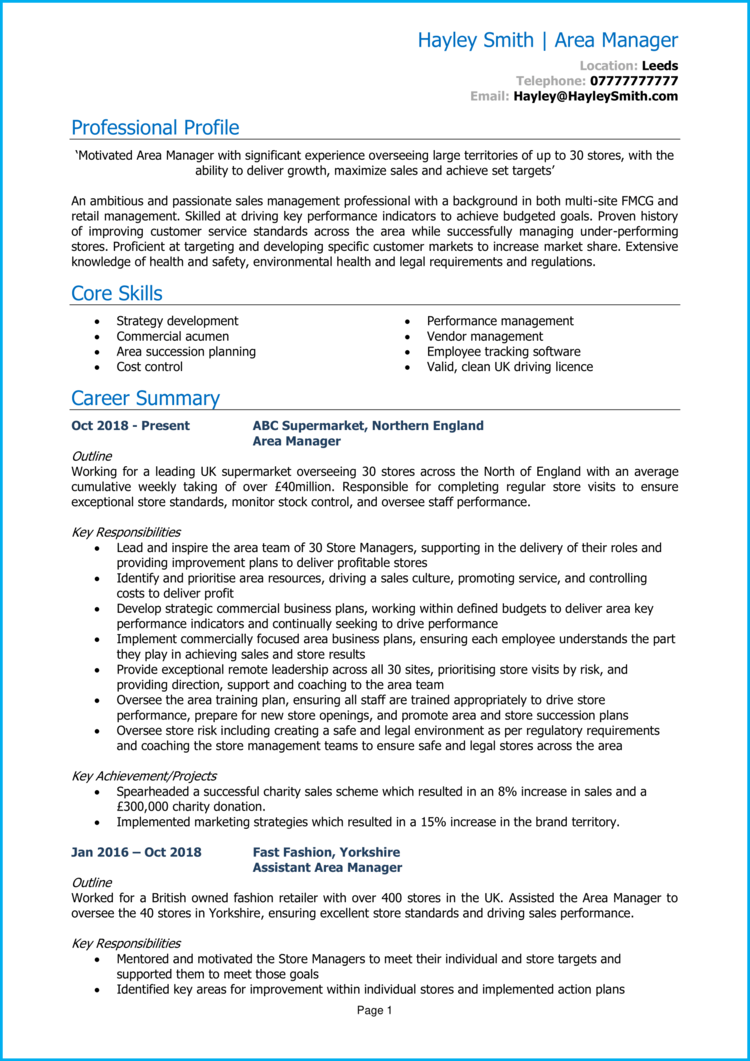
This CV example demonstrates the type of info you should be including within your Chronological CV, as well as how to format and structure the information in a way which looks professional and is easy for time-strapped recruiters to read.
This is the look and feel you should be aiming for, so remember to refer back to it throughout your CV writing process.
Chronological CV structure and format
The format and structure of your CV is important because it will determine how easy it is for recruiters and employers to read your CV.
If they can find the information they need quickly, they’ll be happy; but if they struggle, your application could be overlooked.
A simple and logical structure will always create a better reading experience than a complex structure, and with a few simple formatting tricks, you’ll be good to go.

Formatting Tips
- Length: Two sides of A4 makes for the perfect CV length , though one page is okay for less experienced applicants. This forces you to make sure that every single sentence adds value to your CV and ensures you avoid waffle.
- Readability : Columns, lists, bullet points, bold text and subtle colour can all help to aid the readability of your CV. Your overarching goal should be to make the content as easy to read and navigate as possible, whilst also aiming to make your key skills and achievements stand out.
- Design: Your CV needs to look professional, sleek and easy to read. A subtle colour palette, clear font and simple design are generally best for this, as fancy designs are often harder to navigate.
- Avoid photos: Logos, profile photos or other images aren’t necessary and rarely add any value – save the space for written content, instead!

Structuring your CV
When writing your own CV , break up your CV content into the following key sections:
- Name and contact details – Place them at the top of your CV, so that employers can easily get in touch.
- CV profile – A punchy sales pitch of your key experience, skills and achievements to reel readers in.
- Core skills section – A bullet-pointed snapshot of your abilities.
- Work experience – A well-structured list of your relevant work experience.
- Education – An overview of any relevant qualifications or professional training you have.
- Hobbies and interests – A short description of any relevant hobbies or interests (optional).
Now I’ll guide you through exactly what you should include in each CV section.
CV Contact Details

Write your contact details in the top corner of your CV, so that they’re easy to find but don’t take up too much space.
You only need to list your basic details, such as:
- Mobile number
- Email address
- Location – Don’t list your full address. Your town or city, such as ‘Norwich’ or ‘Coventry’ is perfect.
- LinkedIn profile or portfolio URL – Remember to update these before listing them on an application.
Chronological CV Profile
Grab the reader’s attention by kick-starting your CV with a powerful profile (or personal statement , if you’re a junior applicant).
This is a short introduction paragraph which summarises your skills, knowledge and experience.
It should paint you as the perfect match for the job description and entice recruiters to read through the rest of your CV.

Tips for creating an impactful CV profile:
- Keep it brief: Aim for a short, snappy paragraph of 3-5 lines. This is just enough room to showcase why you’d make the perfect hire, without going into excessive detail and overwhelming busy recruiters.
- Tailor it: The biggest CV mistake? A generic, mass-produced document which is sent out to tens of employers. If you want to land an interview, you need to tailor your CV profile (and your application as a whole) to the specific roles you’re applying for. So, before you start writing, remember to read over those job descriptions and make a list of the skills, knowledge and experience the employers are looking for.
- Don’t add an objective: If you want to discuss your career objectives, save them for your cover letter , rather than wasting valuable CV profile space.
- Avoid cliches: “Determined team player who always gives 110%” might seem like a good way to fill up your CV profile, but generic phrases like this won’t land you an interview. Recruiters hear them time and time again and have no real reason to believe them. Instead, pack your profile with your hard skills and tangible achievements.
What to include in your Chronological CV profile?
- Summary of experience: Recruiters will want to know what type of companies you’ve worked for, industries you have knowledge of, and the type of work you’ve carried out in the past, so give them a summary of this in your profile.
- Relevant skills: Make your most relevant key skills clear in your profile. These should be tailored to the specific role you’re applying for – so make sure to check the job description first, and aim to match their requirements as closely as you can.
- Essential qualifications: Be sure to outline your relevant qualifications, so that anyone reading the CV can instantly see you are qualified for the jobs you are applying to.
Quick tip: Even the best of writers can overlook typos and spelling mistakes. Use our quick-and-easy CV Builder to add pre-written content that has been created by recruitment experts, and proofread by our team.
Core skills section
Underneath your profile, create a core skills section to make your most relevant skills jump off the page at readers.
It should be made up of 2-3 columns of bullet points of your relevant skills.
Before you do this, look over the job description and make a list of any specific skills, specialisms or knowledge required.
Then, make sure to use your findings in your list. This will paint you as the perfect match for the role.

Work experience/Career history
Now it’s time to get stuck into your work experience, which should make up the bulk of your CV.
Begin with your current (or most recent) job, and work your way backwards.
If you’ve got too much experience to fit onto two pages, prioritise space for your most recent and relevant roles.

Structuring your roles
Whilst writing your CV, it’s essential to look at it from the eyes of a recruiter.
If they’re met with giant blocks of text which are impossible to navigate, they might get frustrated and skip onto the next CV.
Instead, make use of the 3-step structure shown below, to give them a pleasant reading experience.

Provide a brief overview of the job as a whole, such as what the overriding purpose of your job was and what type of company you worked for.
Key responsibilities
Next, write up a punchy list of your daily duties and responsibilities, using bullet points.
Wherever you can, point out how you put your hard skills and knowledge to use – especially skills which are applicable to your target role.
Key achievements
Finish off by showcasing 1-3 key achievements made within the role.
This could be anything that had a positive effect on your company, clients or customers, such as saving time or money, receiving exemplary feedback or receiving an award.
In your education section, make any degrees, qualifications or training which are relevant to your target roles a focal point.
As well as mentioning the name of the organisation, qualification titles and dates of study, you should showcase any particularly relevant modules, assignments or projects.
Interests and hobbies
Although this is an optional section, it can be useful if your hobbies and interests will add further depth to your CV.
Interests which are related to the sector you are applying to, or which show transferable skills like leadership or teamwork, can worth listing.
On the other hand, generic hobbies like “going out with friends” won’t add any value to your application, so are best left off your CV.
Writing your Chronological CV
An interview-winning CV needs to be both visually pleasing and packed with targeted content.
Whilst it needs to detail your experience, accomplishments and relevant skills, it also needs to be as clear and easy to read as possible.
Remember to research the role and review the job ad before applying, so you’re able to match yourself up to the requirements.
If you follow these guidelines and keep motivated in your job search, you should land an interview in no time.
Best of luck with your next application!
Chronological Resume Writing Guide 2023
What specifically is a chronological resume and how really should it be written? What might a chronological resume look like in 2023? With increased unemployment rates during the COVID-19 pandemic, the job…
Resume Help - Chronological Resume Writing Guide 2023
- Resume Help
What specifically is a chronological resume and how really should it be written? What might a chronological resume look like in 2023? With increased unemployment rates during the COVID-19 pandemic, the job market is more competitive than ever. The importance of writing a well-structured chronological resume cannot be downplayed at a time like this. If…

Sarah Reynolds
Content specialist.
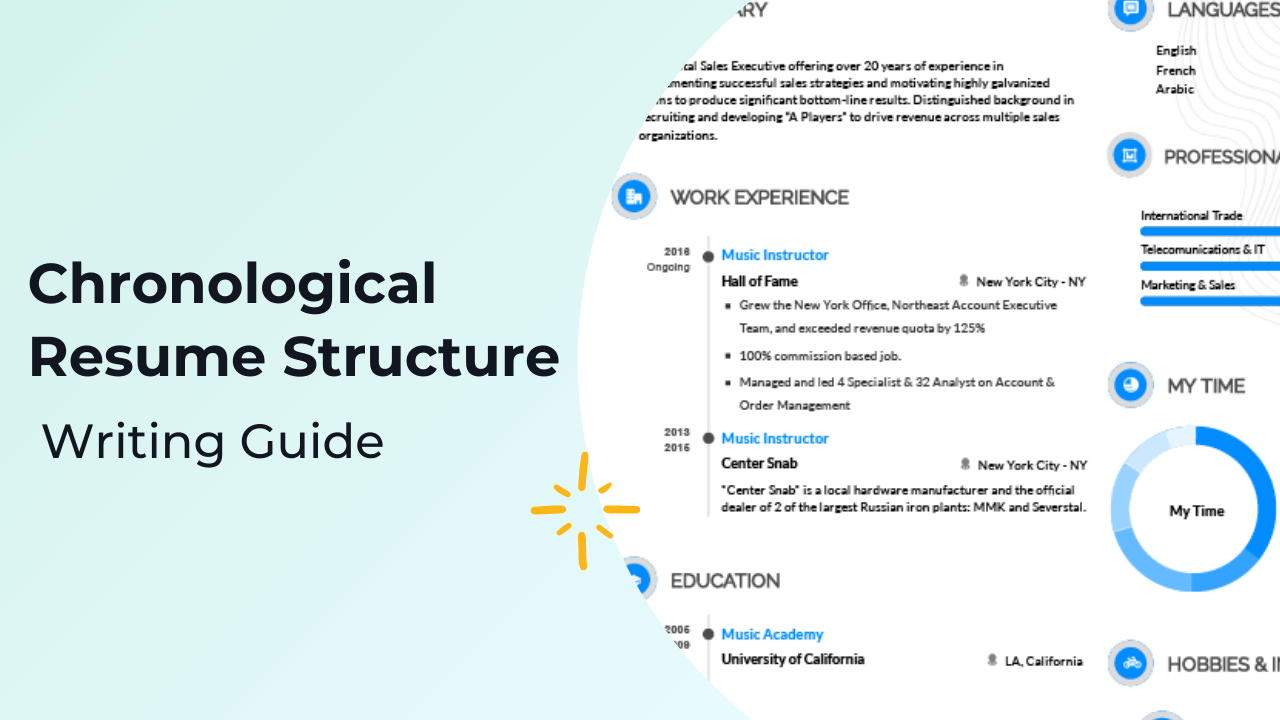
What specifically is a ch r onological resume and how really should it be written? What might a chronological resume look like in 2023?
With increased unemployment rates during the COVID-19 pandemic, the job market is more competitive than ever. The importance of writing a well-structured chronological resume cannot be downplayed at a time like this.
If you want your resume to get noticed , you need to step up your game. Otherwise, your resume—like many others like it—will end up in a junk or trash folder somewhere, extinguishing your hopes of landing that job you had applied to.
A resume is essentially a formal document outlining your professional profile. It categorizes your past qualifications, achievements, and experiences, highlighting the most important details.
There are various styles and formats used for resumes . In this blog, we’ll be discussing one of these styles in detail: the chronological resume.
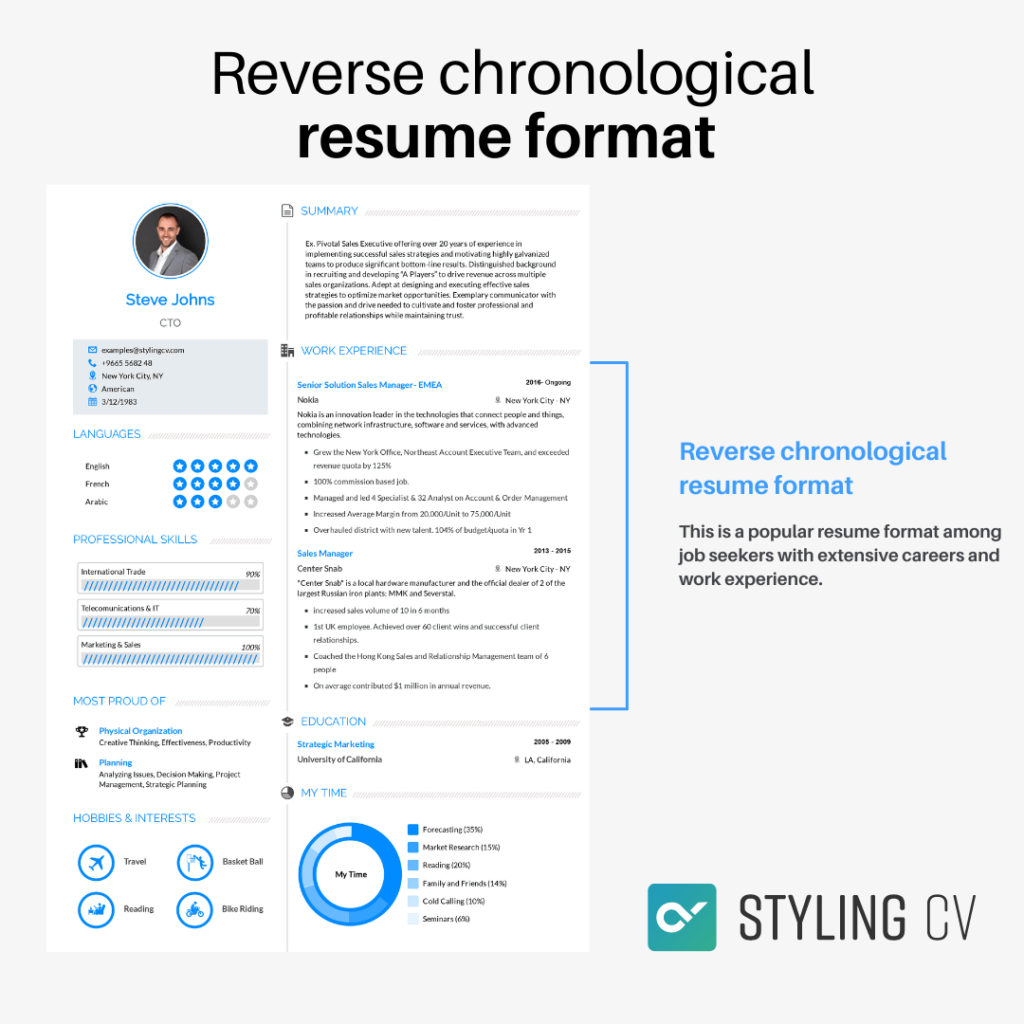
Let’s get started.
What Is a Chronological Resume?
A chronological resume is a type of resume format in which you list all of your work experiences in reverse chronological order, i.e. list the most recent experience at the top of the resume.
The resume starts with your current or the last held position, and continues to list the jobs you had before that. In doing so, it highlights your work experiences and qualifications in an organized and logical way and makes it easier for recruiters to get an insight into your professional profile.
The chronological resume has been popular for several years and is among the most commonly used format for 2023. It’s used by experienced professionals from various industries and backgrounds as it allows them to accurately list facts.
Since the focus is on the reverse chronological order being utilized, your resume must contain all relevant dates throughout the document. This applies to all of your professional, academic, voluntary, or extracurricular experiences listed in the resume.
how to write a chronological resume?
- Include a list of your contact details.
- Start off with a powerful resume introduction.
- Write about your professional history in reverse chronological order.
- Include a succinct section about education.
- Describe your skills.
The Benefits of Using a Chronological Resume
Wondering why chronological resumes are so popular? The simple and to-the-point format makes it easier to convey and absorb information. This helps both recruiters as well as job seekers.
The format of a chronological resume also helps clearly display career progression. Recruiters can easily get a glimpse of applicants’ journeys and use the reverse order to trace back their careers.
Chronological Resume Structure
The resume structure is fairly straightforward. The prime objective here is to ensure that all of your qualifications and experiences are listed in reverse chronological order.
The resume structure includes:
- Contact details
- Resume summary/objective
- Professional experiences and work history
- Academic qualifications and educational background
- Relevant hard/soft skills
Additionally, you may also include certain optional sections in your resume to highlight your voluntary experiences, language proficiency, or certifications.
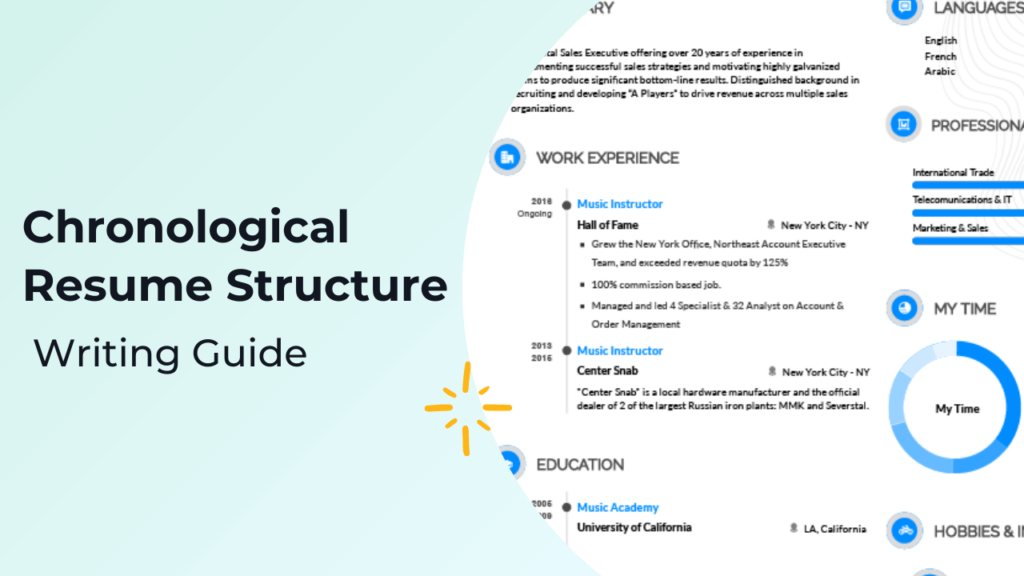
A Step By Step Guide to Creating a Chronological Resume
As you may have noticed, the structure of a chronological resume isn’t all too different from the traditional resume format you’re used to seeing. It has the same sections that most resumes use. So, what sets a chronological resume format apart? The trick is in how you curate each section.
Let’s go over this in detail:
1. Start by Filling in Your Contact Details
The contact section sits at the very top of the resume, usually aligned to the left or at the center. This section should include your:
- First and last name
- Email address
- Phone number
- Location (city)
Make sure the information you enter is accurate and free of any typos or errors. This is what recruiters will use to contact you if you match their requirements, so you don’t want to enter the wrong digits or miss a letter in your email address.
You can also choose to include the URL to your LinkedIn profile. Do this only if your profile is up to date and organized. You may also add URLs to other social media accounts if they’re relevant to the role or the industry you’re applying to.
For instance, if you’re applying for an interior designing position, you can share your Instagram or Facebook profile where you’ve added pictures of your previous work.
2. Write Your Career Statement
The next thing to add to your chronological resume is your career statement or candidate profile. This is done in the form of either a resume summary or a resume objective.
A resume summary is a brief overview of your professional experiences. It’s used by individuals who have several years of work experience. On the other hand, a resume objective highlights your career goals and aspirations.
It’s mostly used by candidates who have limited work experience, such as those looking for entry-level roles or planning on switching careers.
3. Elaborate on Your Work Experience
Here comes the main crux of your resume: the work experience section. This is undoubtedly the most important part of your resume as it highlights all that you’ve done and achieved over the years. It’s also where the reverse chronological order comes into play.
As discussed above, you need to list your work experiences starting from the most recent one. Here’s how to go about it:
- Start by stating your current/latest designation as the first heading within the section
- State the company name alongside the designation
- Mention the dates of employment next to the job title, including starting and ending dates. If you’re currently employed at the job, replace the ending date with “present”
- Beneath the heading, list your core responsibilities and achievements (e.g. “Managed the company’s official social media platforms”)
The text should look something like this:
Marketing Head – XYZ Firm (2019 – 2023)
- Executed successful marketing campaigns for international brands such as “A”, “B”, & “C”
- Conducted training seminars and marketing workshops for internal teams
- Set up an in-house social media management team
Follow the same pattern for every job entry as you move down the chronological order.
Make sure you highlight your quantifiable achievements wherever possible. Avoid using lengthy sentences or wordy chunks of text, keeping things concise and to the point.
Don’t forget to tailor your resume according to the role you’re applying for! If you’ve worked multiple jobs in the past, exclude the ones that are irrelevant or emphasize more on the most relevant ones.
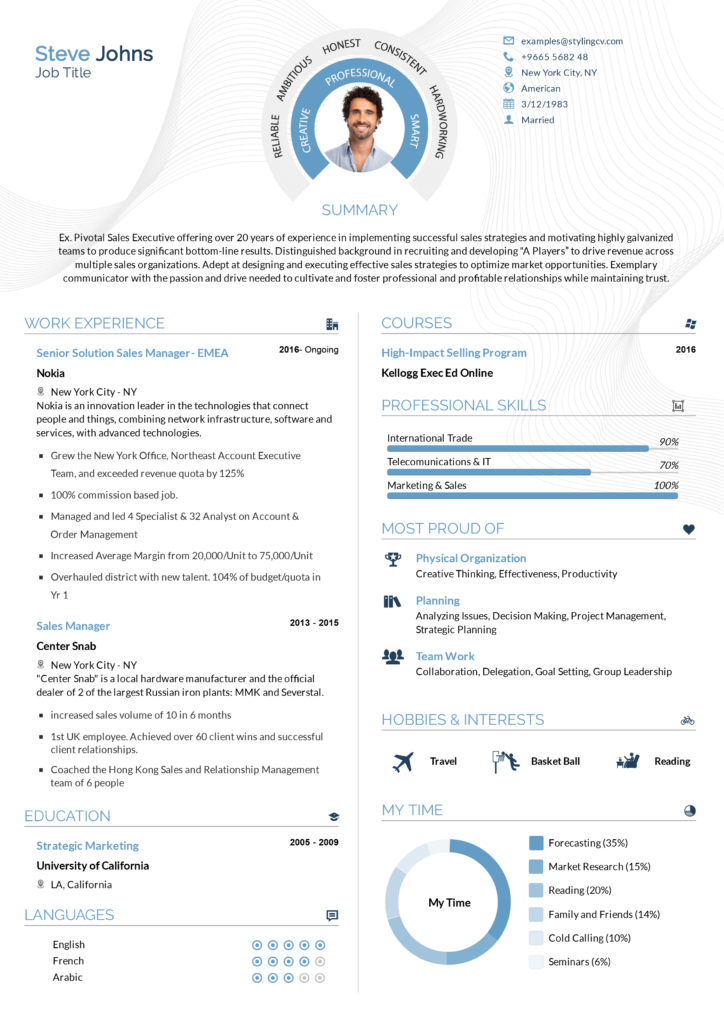
4. Mention Your Educational Background
Once you’ve listed your work experiences, follow the same strategy to fill out your education related details in reverse order. This section doesn’t need to be as elaborate as the work section, though. Here, you only need to focus on what you studied, when you studied it, and where you studied at.
For instance, if you hold a Master’s Degree and are currently pursuing your PhD, there’s no need to mention your high school diplomas. You can simply include your previous and ongoing college degrees.
On the other hand, if you’re a fresh graduate or have limited work experience, you can include your high school education alongside your undergraduate degree.
For every qualification that you include, don’t forget to mention the:
- Degree & program name
- Name of the educational institute
- Period attended
You may also mention your CGPA, majors/minors, and academic achievements. Unlike the work experience section, you don’t need to elaborate on your courses or study matter under each heading.
5. Impress With Your Skills
Finally, it’s time to show recruiters what you’re capable of in the skills section. The reverse chronological order isn’t really applicable here. You can list all of your hard and soft skills , choosing the ones that are the most relevant to the role you’re applying for.
Hard skills are technical, measurable abilities needed for a job. For instance, Cloud Computing or knowledge of Photoshop would count as hard skills .
Soft skills are interpersonal skills that reflect your personality. They may include your critical thinking skills, communication skills, and leadership skills.
Don’t downplay what you’re capable of! Include a balance of hard and soft skills, listing the most relevant ones at the top.

6. Include Optional Sections
Once you’ve added all the core details in your chronological resume, think of what additional information can be included in it. This is where you turn to optional sections to earn yourself some brownie points.
Optional sections may include:
- Community or voluntary work
- Languages (applicable if you’re fluent in more than one language)
- Hobbies & interests
- Extracurricular activities & memberships
- Awards & certifications
Be smart about what you include!
Who Should Use a Chronological Resume?
We’ve discussed at length what the structure of a chronological resume looks like and what each resume section entails. Now it’s time to look at who benefits from this resume format.
One of the best things about a chronological resume is that it can be used by just about any job seeker, irrespective of their industry or experience. Most job seekers are familiar with the layout and find it to be an easy way to organize their professional and academic information.
In other words, there’s no specified group of job seekers and candidates to whom this resume style is beneficial to. Anyone can use the format and tailor it as per their experiences and requirements.

That said, there’s no denying that a chronological resume is most effective for applicants who have solid work experience. The format enables them to easily list all of their accomplishments, most recent to first, and show recruiters that they have sufficient experience and skills.
There are also instances where using a chronological resume isn’t the best option. Sure, you can use it and tailor it according to your needs, but there are other formats that can help you more.
For example, if you’re switching careers and your last three jobs have been in a completely different field, you should use a functional resume style. This will allow you to highlight your skills needed for the industry you’re aiming to be a part of, while also showcasing your work history.
Similarly, if you’ve switched jobs one too many times or have gaps in your resume, then it’s best to use a format that diverts focus from these aspects. Instead of using a chronological resume, you can use a combination approach blending the functional and chronological styles.
Bonus Resume Tips
As important as the formatting and structuring of your resume is, you can’t neglect the content itself. Everything that you include in your resume should be accurate, well-written, and impactful.
- Use bullet points when mentioning their accomplishments and qualifications
- Be as concise as you can be and use action verbs to highlight the impact you made at your job instead of just listing down your duties
- Use relevant keywords to prevent your resume from getting lost in an applicant tracking system.
- Proofread every single thing you write and triple-check for grammatical errors and spelling mistakes
- Keep your resume one page long and include only the most relevant details
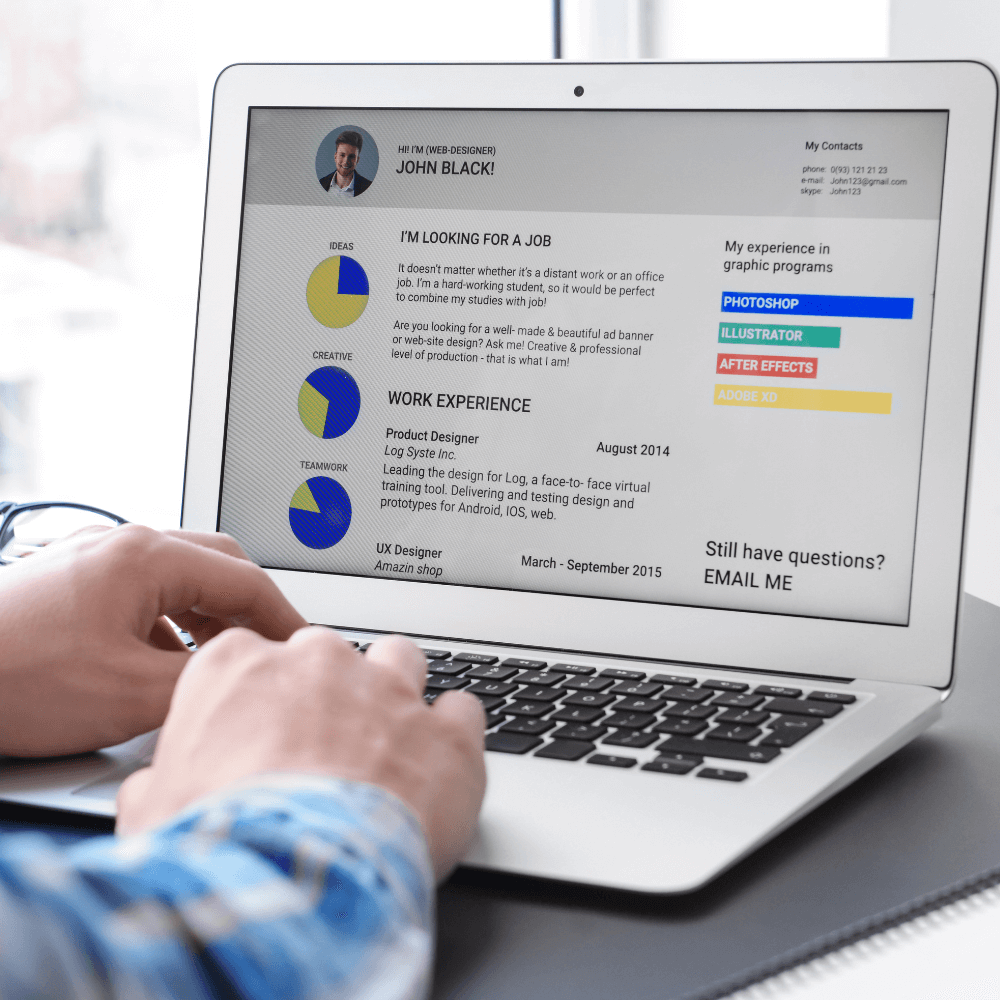
Remember, there’s no one-size-fits-all approach that you can use for your resumes. Revise your resume each time you’re applying for a role, tailoring it according to the job requirements and expectations.
Also get in the habit of updating your resume periodically so that you don’t forget to include recent accomplishments and always have a draft ready to send at a moment’s notice.
1- What are the 5 parts of a chronological resume?
Your chronological resume should have the following five sections: contact information, summary, work experience, education, and supporting information. They are arranged in this post according to the queries that each section must address.
2- Is CV written in chronological order?
On a resume, work history should always be listed in reverse chronological order. Your employment history should start with your current or most recent position at the top and work its way down to your oldest but still relevant position.
3- How do you do chronological format?
- Back Heading. NAME, FIRST AND LAST.
- Resume Introduction. Dedicated professional with [number of years] years of experience in [business].
- Work or Practical Knowledge. Recentest Job Title.
- Education. Name of degree/major.
- Competencies and Certifications
- Extra Section for Your Resume.
4- Why do we use chronological resume?
Employers can more easily appreciate the significance of your most recent and pertinent work experiences when reading a chronological resume. Prioritizing the most recent information on a resume helps ensure that your experience is visible because employers may only spend a few seconds reviewing each one.
Your Go-To Resume Building Platform
Having trouble creating the perfect chronological resume? That’s what we’re here for!
Styling CV helps job seekers and applicants get one step closer to their dream jobs by providing them with the tools needed to create impressive CVs and resumes.
We offer customizable resume templates for all industry types to accommodate each individual applicant’s needs to help them qualify for the job interview. You can also use our Resume Builder to create the perfect profile.
Create your basic account today to give it a try for free and design your chronological resume!
Related articles

The 10 Most common interview questions and answers 2023

Writing a Resume without Work Experience
Build your resume in 10 minutes.
Use professional field-tested resume templates that follow the exact ‘resume rules’ employers look for. Create My Resume
Hundreds of Resume Templates
Choose from hundreds of professionally designed and ATS-friendly resume templates Build Your Resume Fast and Easy.

Want Free Resume Templates?
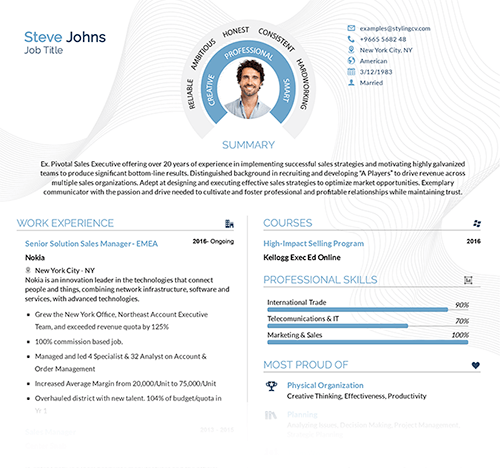
What Is A Chronological Resume?
A chronological resume, also known as a reverse chronological resume, lists a job seeker’s professional experience starting with the most recent activities and works backwards from there. This is the most common type of resume as it shows employers your career progression and growth. A hiring manager can immediately see your most recent position before they see earlier work, such as junior positions or internships. The chronological resume format is most commonly used by job seekers with a good deal of professional experience – ideally with few work gaps. A chronological resume isn't the best match if you have little experience, large work gaps, or are in the middle of a career switch.
Why Use a Chronological Resume?
Chronological resumes are the most popular type of resume, but there are still specific job seekers who benefit from them the most. You can get the most out of a chronological resume format if:
- You have several years' worth of professional experience in one field or industry
- You have consistent experience using similar skills or in similar roles
- You have very few gaps between jobs
- The job you’re applying for puts heavy importance on experience
Another reason to use a chronological resume is simply that hiring managers are accustomed to looking at them, making it comfortable for them to read.
Of course, nothing’s perfect and certain job seekers won’t experience the benefits of chronological resumes. Here are a few types of job seekers who may want to avoid using the chronological resume format:
- People who are career-switching
- People with large work gaps
- New professionals with little or no experience
- Expert generalists with skills in multiple fields
For these job seekers, a chronological resume may obscure their real skills and capabilities. For instance, a chronological resume would display that a generalist has a mixed work history in unrelated fields, instead of showcasing their myriad transferable skills.
“The chronological resume format is most commonly used by job seekers with a good deal of professional experience – ideally with few work gaps.”
What Does a Chronological Resume Include?
A reverse chronological resume follows a very standard structure, usually including the following sections:
- Contact information : You should always include your contact information at the very top, including your full name, phone number, email address, and LinkedIn profile.
- Professional title and summary : A quick summary of your professional experience, skills, and achievements.
- Work or educational experience : This is the main section of a chronological resume. This section should detail your professional experience, starting from the most recent position, and work backwards.
- Relevant skills : This section should list role-relevant hard and soft skills.
- Optional sections : These sections can be anything relevant to you that makes your resume stand out, such as Languages and Volunteer Work.
Please note that this is the most common structure, but chronological resumes can follow a variety of formats as long as your reverse chronological experience is at the top after your professional summary.
How to Write a Chronological Resume: Step-by-Step Guide
Now let’s take those steps and use them to write a chronological resume step-by-step.
1. Add contact information: Start by adding your full name, phone number, email address, and location. It’s also common to provide a link to your LinkedIn profile.For people in creative fields, you should also include a link to your professional portfolio.
2. Build your professional summary: Now craft a professional summary – these are generally two to three sentences. Your summary is an overview of your experience and skills and gives quick context to the hiring manager so they can determine your fit.
3. Add your work experience: This is the most crucial aspect of a chronological resume, so it will take up the most space. Start with your most recent job role and include any relevant experience from the past ten years.
For each entry, list your job title, employment dates, and company name. Include your location if it’s applicable – it isn’t relevant to include if the role was fully remote. Detail your main responsibilities and achievements with bullet points to make them easier for the recruiter to scan.
4. Detail your education: Next, you’ll want to list your education in the same format as your experience, starting with your most recent degree and continuing in reverse chronological order.
Provide the full name of your degrees and the educational institution where you earned them. Please note that if you’re a recent graduate, this section should replace your work experience section.
5. Enrich your resume with relevant skills: In this section, list your hard and soft skills. It’s important that you choose highly relevant skills, so review the job ad and find which skills the employer wants.
Note: It’s also a good idea to use the same wording as the employer to make your resume ATS-friendly . For instance, if the job ad calls for a sales professional with persuasion skills , ensure you use “persuasion” instead of “negotiation.”
6. Consider additional sections that showcase your qualifications: The last sections are optional but useful:
- Certifications
- Volunteer Work
- Hobbies and Interests
If you have relevant achievements for these sections, we encourage you to add them. For instance, showcasing your passion for travel in “Hobbies” and your Spanish proficiency in “Languages” improves your chances of securing a tourism job.
Work Experience Section: Tips and Examples
Let’s cover some strategies for creating your work experience section, as it’s the most important part:
- Start with your job title, then list the company name and your start and end date. If you’re still working for the company, list the date as “ Present.”
- Under this, add three to five bullet points detailing your key responsibilities and largest achievements. Ensure you start each bullet point with an action verb like “planned,” “implemented,” and “increased.”
- If you’re adding achievements, use quantifiable data to describe them as this makes a greater impact, such as “ Increased profits by 15% .”
Here’s a quick chronological resume example for an elementary teacher:
Elementary School Teacher
Reed Valley Elementary, Knoxville, TN
October 2020 – Present
- Improved student test scores by 20% and pass rate by 25% from 2020-2021 school year to 2021-2022
- Organized a classroom and curriculum for a class of 30 children
- Collaborated with fellow teachers to design a new test structure
Here’s another example, this time for an administrative assistant:
Administrative Assistant
Golde Insurance, Eugene, OR
April 2017 – June 2021
- Provided administrative assistance for 6 senior executives
- Managed office schedules, coordinating events, meetings, and seminars
- Implemented and managed scheduling software, improving productivity by 20% and reducing no-shows by 15%
- Verified and processed 50+ client applications per week
These samples clearly display significant achievements and quantifiable data. Hiring managers have little time and you want them to see your qualifications quickly. We recommend using these samples as a quick chronological resume template so you can build your own.
Expert Tip:
Certain fields, like computer programming, focus heavily on the skills you know and your work experience. For roles like these, try a hybrid, or combination resume. These resumes prioritize both work experience and skills by placing them both at the top, usually in separate columns.
How to Tailor a Chronological Resume for Different Jobs
A chronological resume format is straightforward, but there are ways to personalize it depending on your industry. Modifying your resume to better suit the job you’re applying for is an excellent strategy and helps capture the attention of the hiring manager.
Here are a few industries and tips to tailor your chronological resume accordingly:
- Business and sales : Include measurable achievements, especially concerning company budgets and profits
- Computer engineers: Put an emphasis on all relevant hard skills and clearly list them
- Project managers: In your experience section, list responsibilities and achievements, but ensure to list completed projects and any details possible
- Web developers: Prioritize your highly specific coding languages and any specialty boot camps you’ve attended
- Medical professionals: List your relevant college degrees prominently, possibly in a nearby column to ensure recruiters can quickly glance at them
- People-centric roles: Positions like teachers and charity workers should list volunteer experience higher than other job seekers to show their experience helping people
Take some time to consider what’s important to your role. Review the job description and think critically about the related skills, hobbies, and interests. It might be worth your time to talk to other people in your industry and ask them what matters at their company to get another perspective.
Common Mistakes to Avoid on a Chronological Resume
Before we finish up, let’s quickly cover some common pitfalls when you write a chronological resume and how to avoid them. Here are the most common ones:
- Listing too much experience: Stick to your last 10 to 15 years of experience, keep it highly relevant, and try not to let it spill beyond one page (two pages if you have extensive experience)
- Listing irrelevant experience: Don’t list any experience that isn’t in the industry you’re applying for – even if it’s recent.
- Listing too many responsibilities or achievements: Add 3 to 5 bullet points under each piece of experience and no more. Don’t overwhelm the recruiter.
- Listing irrelevant responsibilities: Ensure you list important, impactful responsibilities. Don’t list anything too obvious or commonplace.
Build a Winning Chronological Resume
The chronological resume is the most popular type of resume and it’s easy to see why. It provides recruiters with a concise view of your professional experience so they can make an informed decision faster. Use our tips above to avoid common mistakes, craft a well-formatted resume, and show employers your qualifications. Short on time? Grab a chronological resume template from CVwizard’s Resume Builder to get started now.
Make an impression with your resume
Create and download a professional resume quickly and easily.

Survey Reveals New Insights on the Job Market

Should you put your address on your resume?

10 Resume Tips To Help You Land Your Dream Job

Everything You Need to Know About a Chronological Resume [25 Examples]
We place the most recent employment on the top, followed by the older ones, so it is also called the reverse chronological order.
A chronological resume, also known as “reverse chronological resume” is the most commonly used resume format. Recruiters all over the world prefer it because of its straightforward and easy-to-read style.
If you have a rich work history, a chronological resume format is an ideal choice for you. Due to its powerful impact, it’s necessary to know what a chronological resume is and how to write one perfectly.
In this article, you will read about:
- What is a chronological resume?
- Advantages of a chronological resume
- Disadvantages of a chronological resume
- Structure of a chronological resume
- When to use a chronological resume
- When not to use a chronological resume
- How to write a chronological resume?
- Skills for a chronological resume
- Additional tips to write an impactful chronological resume
What is a Chronological Resume
A chronological resume displays your work history and achievements in the order of their occurrence. We place the most recent employment on the top, followed by the older ones, so it is also called the reverse chronological order. Your most recent employment, education, or achievement comes at the top followed by the earliest one at the bottom. The ability to showcase a candidate’s relevancy to the skills and experiences makes chronological resumes a big hit among recruiters.
Work experience being the main highlight, chronological resumes are the perfect choice for people with a rich and vast work history .

Source: Resume Genius
Advantages of a Chronological Resume
A well-tailored chronological has many advantages for applicants. The key benefits are
- A chronological resume helps ATS (Applicant Tracking Systems) to read and review the whole resume quicker with better efficiency.
- It highlights your work history, giving recruiters a better place of where and how long you have worked in the past.
- Because of it is common, every recruiter is used to scanning resumes in chronological format. This ensures that they are able to find the exact information they need.
- It helps you to reflect on your job profile advancements with time in your career, giving a professional growth perspective to the recruiter.
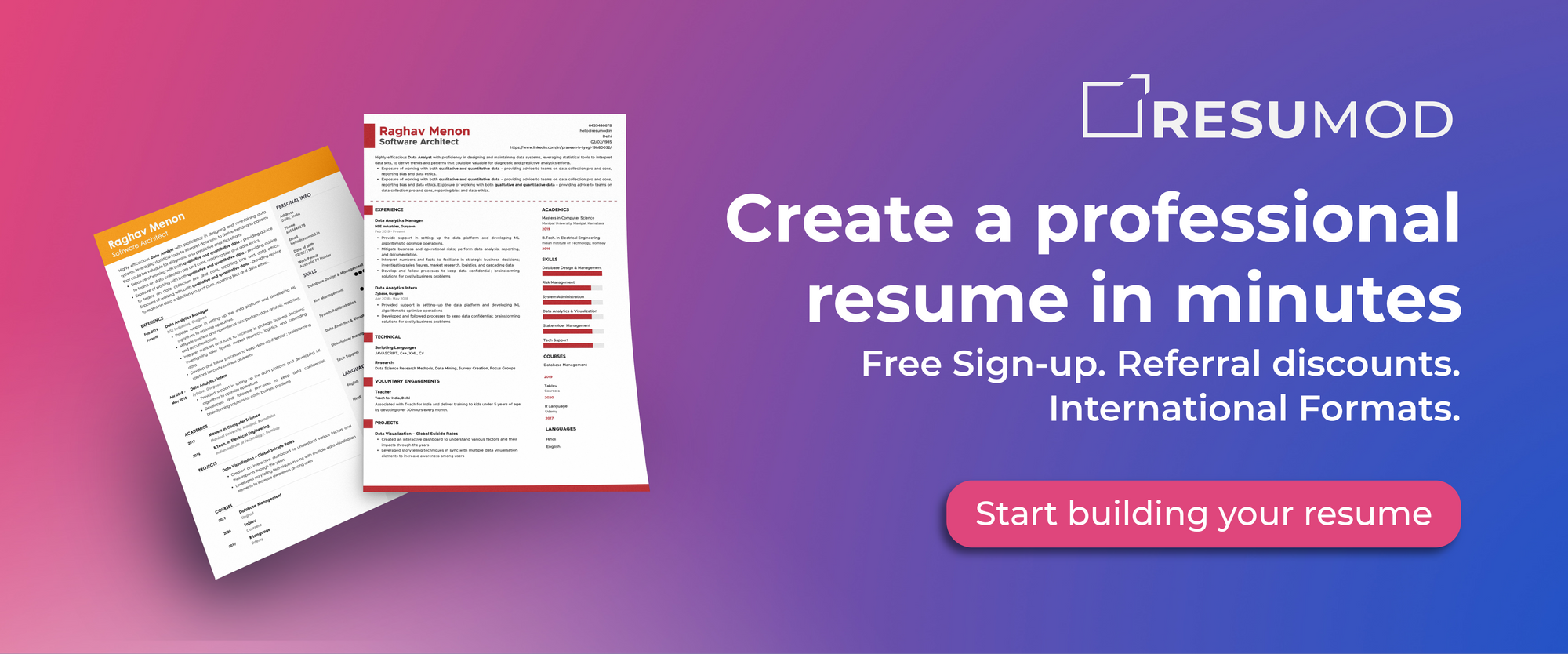
Disadvantages of a Chronological Resume
- The employment gap is significantly visible in the chronological resume, which raises additional questions of your absence from work
- Your skills, education, projects, etc., are all overshadowed by your work experience.
- As your job tenure is also written, short tenure spent at various companies showcases you as a “job hopper”. Most recruiters avoid job hoppers for obvious reasons, thus putting you at a huge disadvantage.
- Being a very common resume format, it’s really hard to stand out from other candidates.
Structure of a Chronological Resume
The structure of a chronological is fairly simple yet very organized and impactful.
The right structure with all sections is as follows:
- Contact information
- Professional Objective or Summary
- Work Experience in reverse order
- Skills Section
- Education in chronological order
- Other Achievements or Certifications
When to Use a Chronological Resume
Ideally, you use chronological resume format, if you follow these conditions:
- You have a rich employment history with some prestigious companies to show off
- Your skillset is packed with both technical and soft skills relevant to the job
- You have consistent work experience without any major job drops
- Your work experience acquires a steady advancement in job positions
When Not to Use a Chronological Resume
- You have a lack of experience or a fresher
- Your skills are not relevant enough for the applied job
- You have any visible gaps in your experience
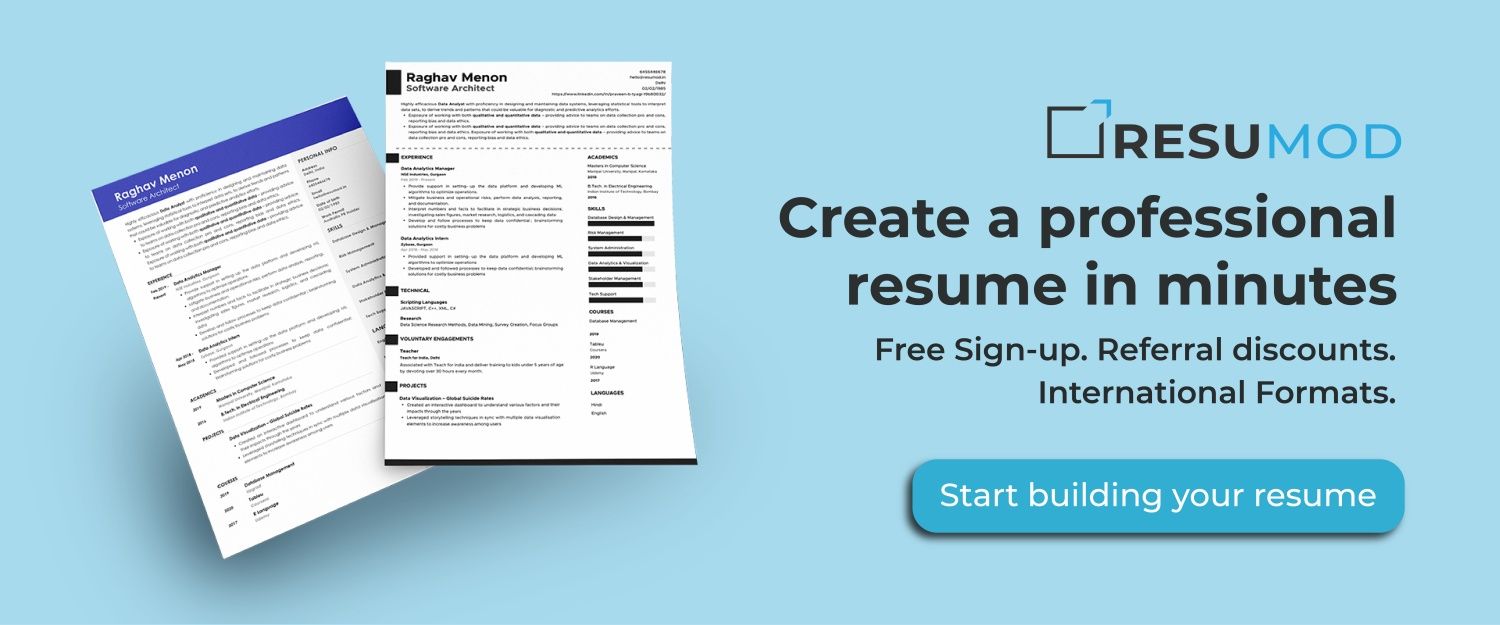
How To Write a Chronological Resume?
Now that you are aware of what and where to use a chronological resume, let’s dive into how to write a chronological resume that brings results.
- Contact Information: This section includes your full name, city, state, ZIP code, telephone number, professional email address, and links to your LinkedIn profile (optional) or your professional website (if any).
- Professional Objective or Resume Summary: Your professional objective speaks about aspirations and skills. It is written in clear, active language. Generally, it’s used for those with less experience or looking for a change of job profile.
However, a resume summary overviews your past experiences in a short concise form, making it ideal for chronological resumes.
- Work Experience in Reverse Order: Your work experience is the key aspect of a reverse chronological resume, thus it's necessary to write it in the correct format. Make sure you include your latest job at the top and then move backward with the earliest job at the bottom.
For each company, add the name of the company, title of the position, tenure, and location of the job. Do mention key responsibilities or achievements for each company. Keep everything organized and concise, and use bullet points to organize.
Mark the company name and your job profile in bold for each company. Also, make sure your past experiences are somehow relevant to the applied job. If you feel anything about past work experiences is not relevant, feel free to omit it and save space for other things.
- Skills Section: Present both your technical and soft skills in bullet points for better organization. Write skills that complement your past experiences and are aligned with the required skills for the applying job.
- Education: This section includes your complete school or college name, location, and the achieved degree. Mentioning the tenure is completely optional. You can also mention any remarkable honors or certifications achieved during your education. No need to mention GPA, if you are not confident about it.
- Other Achievements or Certifications: The achievements or Certifications section is completely optional. You can mention any relevant voluntary work, guest seminars, research papers, skill certifications, remarkable honors, etc., in this section. Only mention those which are relevant and worth mentioning in your resume.
Skills for a Chronological Resume
Skills for academic resumes in chronological format.
- Team Leadership
- Administration
- Higher Education Guidance
- Decision Making
- Relationship Building
- Career Counseling
- Admission Process Management
- Recordkeeping & Database Management
- Correspondence Management
- Appropriate Course
- Educational Goals Attainment
- Academic Support
- Education Administration
- Classroom Evaluation Methods
- Teacher Mentoring & Development
- Academic Progress Tracking
- Student Discipline & Safety
- Technology Enhancements
- Curriculum Planning
- Teacher Development
- Education Administration & Leadership
- School Personnel & Teacher Management
- Conflict Resolution

Skills for BFSI resumes in chronological format
- Adherence to underwriting Guidelines
- Customer Service
- Insurance Underwriting
- Policy Terms
- Legal Documents
- Claims Management
- New Insurance Policies
- Portfolio Management
- Mutual & Hedge Funds
- Quantitative Analysis
- Client Relations
- Capital Markets
- Private Equity
- Client Relationships
- Financial Models
- Mergers & Acquisitions
- Due Diligence
- Lending Regulations
- High-Risk Account Reviews
- Data Collection and Analysis
- Risk Assessment Procedures
- Customer Handling
- Administration Support
- Documentation Review
- Business Flair
- Marketing Expertise
- Research Skills
- Quantitative Trading
- Intra- Day Trading
- Quantitative Data Analysis
- Low/ High Trading
- Risk Management
- Frequency Trading
- Forecasting/ Market Trend Analysis
- Financial Products
- Investment Products
- Stock Market Knowledge
- Cold Calling
- Risk Analysis
- Credit Evaluation
- Client Relationship Management
- Asset Based Lending
- Billing and Collections
- Loan Servicing

Skills for engineering resumes in chronological format
- Web-Based Software Engineering
- Coding & Debugging
- Troubleshooting & QA
- Technical Documentation
- Machine learning
- Agile development methodologies
- Automation Testing
- Manual Testing
- Requirement Gathering
- Data Driven Framework
- Hybrid Framework
- Continuous Integration
- UAT Testing
- Functional and Regression Testing
- Version Control
- Test Reporting
- Test Preparation and Review
- Test Execution
- Project Scoping
- Test Equipment Maintenance
- Troubleshooting
- Object-oriented programming
- Writing User Manuals
- Technical Support
- Quality Control/Assurance
- On-site Support
- Blue Prints & Schematics
- Troubleshooting/Testing
- Industrial PC Configurations
- Cloud Infrastructure
- Database Management
- Service Level Adherence
- Maintenance and Repairs
- System Security
- Documentation & Reporting
- Installation & Configuration Support
- Applications Support
- Team Coordination

- Inventory Management
- Desktop Support
- Active Directory
- Systems Analysis and Evaluation
- Operations Research
- Data Management
- Technical Measurements
- Product Testing and Quality Control
- Work Cell Design
- Production Planning
- Process Management
Skills for healthcare and medical resumes in chronological format
- Clinical Medicine
- Patient Relationships
- Primary Medical Care
- Medical Examinations
- Family Medicine
- Surgery Support
- Treatment Planning
- Patient Management
- Differential Diagnosis
- Pharmaceutical Knowledge
- Medical Devices
- Medical Equipment
- Data Acquisition
- Medical Instruments Mangement
- Preventive Maintenance
- Project Management
- Diagnostic Skills

- Specialized Medicine
- Evaluation and Diagnosis
- Patient Care Plans
- Laboratory Equipment Maintenance
- Tympanometry
- Otology and Rhinology
- Pediatric ENT
- Visuospatial awareness
- Communication
- Organizational Ability
- Patient Care
- Disease Management
- Medication Management
- Medical Records Management
- Test Results Interpretation
- Diagnosis and Treatment
Skills for hospitality resumes in chronological format
- General/ Office Administration
- Quality and Safety Compliance
- Client Relationship Building
- Projects Administration
- Records Management
- HR and Training Support
- Cross-functional Team Collaboration
- Reports Preparation and Filing
- Scheduling and Coordination
- Team Building
- Cost Containment
- Facilities Management
- Guest Relations
- Quality Assurance
- Spa Management
- Facility Management
- Strong Communication
- Team Management
- Staff Training

- Restaurant Operations
- F&B Management
- Staff Training and Development
- Process Improvement
- Restaurant Management
- Purchasing/Inventory Management
- Facilities/Safety Management
Additional Tips to Make an Impactful Chronological Resume
Keep your resume limited to two pages.
On an average, recruiters spend about 5-6 seconds to scan one resume. Yes, you just have 6-seconds to get through.
Its therefore important to tailor your resume and make it crisp enough to convey your skills. Don't stuff your resume up with every piece of information you have to put in.
Concise your information in a page or two with all relevant sections.
Don’t List More than 10 Years of Experiences
Based on the hiring trends, recruiters usually refer to your latest 5-10 years of experience unless mentioned.
Explain up to 1o years of work experience. For your jobs done before the last 10 years, mention your employer name, job role, and dates of employment.
Attach a cover letter to complement your chronological resume
You can strongly reflect your genuine interest in the job by attaching a cover letter along with your resume. A cover letter generally grabs the recruiter’s attention. Mention anything in the cover letter that is not written in your resume to stand out even more.
Chronological Resumes on Resumod
Academic resumes in chronological format.
Resume of PGT Math

Check the full resume of PGT Math in text format here
Resume of instructional designer

Check the full resume of instructional designer in text format here
Resume of admissions officer

Check the resume of admissions officer in text format here
Resume of school principal

Check the full resume of school principal in text format here
Resume of History Professor

Check the full resume of History professor in text format here
BFSI resumes in chronological format
Resume of KYC Analyst

Check the full resume of KYC Analyst in text format here
Resume of institutional banker

Check the full resume of institutional banker in text format here
Resume of insurance underwriter

Check the full resume of insurance underwriter in text format here
Resume of credit analyst

Check the full resume of credit analyst in text format here
Resume of financial markets broker

Check the full resume of financial markets broker in text format here
Engineering resumes in chronological format
Resume of software engineer

Check the full resume of software engineer in text format here
Resume of equipment testing engineer

Check the full resume of equipment testing engineer in text format here
Resume of service engineer

Check the full resume of service engineer in text format here
Resume of desktop support engineer

Check the full resume of desktop support engineer in text format here
Resume of industrial engineer

Check the full resume of industrial engineer in text format here
Healthcare and Medical resumes in chronological format
Resume of junior doctor

Check the full resume of junior doctor in text format here
Resume of biomedical engineer

Check the full resume of biomedical engineer in text format here
Resume of physician

Check the full resume of physician in text format here
Resume of ENT specialist

Check the full resume of ENT specialist in text format here
Resume of homeopathic doctor

Check the full resume of Homeopathic Doctor in text format here
Hospitality resumes in chronological format
Resume of front manager

Check the full resume of front manager in text format here
Resume of GM-hotel

Check the full resume of GM-hotel in text format here
Resume of F&B manager

Check the full resume of F&B manager in text format here
Resume of spa manager

Check the full resume of spa manager in text format here
Resume of restaurant manager

Check the full resume of restaurant manager in text format here
This was all about writing a perfect chronological resume that gets you the win in the industry. If you are feeling stressed about writing a chronological resume, you no longer have to! We offer the best resume writing services to help you get closer to your dream job.
Try Resumod's professional Resume builder now!
- Knowledge Base
- Free Resume Templates
- Resume Builder
- Resume Examples
- Free Resume Review
How to write a chronological resume?
[ Click here to directly go to the complete chronological resume sample ]
That means recording them in the order of their occurrence.
Reverse chronology, on the other hand, narrates a story with the recent plot first and flows in the reverse order of occurrence.
A reverse chronological resume format holds a lot of significance as it is often adjudged to be the standard norm for all industries.
So what is a chronological resume format? When is a chronological resume not advantageous and when should you use it? How to write a chronological resume?
Well, this guide is going to answer all these questions and more about the famed reverse chronological resume format.
In case you want the summary, here it is:
- List the most recent job frist and then date back to the previous ones.
- Write dates (in mm/yy - mm/yy) format thoughout your resume.
- Helps in highlighting the professional experience section.
- Do not use this format if you have career gaps as it will highlight that.
- This format is ATS compliant which helps you get through the ATS scanner.
By the end of this guide you will learn:
- What are the different resume formats?
- Why should we use a reverse chronological resume? )
- How to write a reverse chronological resume?
- How to mention training & certifications in a chronological resume?
To start with, and to explain to you the importance of dates generally, read the section below.
According to Silvia Rosenthal & Janet Hale in their book 'A Guide to Documenting Learning', bloggers are often advised to put recent dates to otherwise old articles.
This is done to give the readers the feeling that the post is recently written which generates enough interest in the reader's mind.
You can find this universally across multiple domains and industries. Newspapers and media platforms thrive on giving you the most recent updates and the same is followed in the blogging industry. Google posts recently-updated websites and articles first.
The same logic applies to a resume.
Recruiters are more interested in seeing your latest achievements & credentials first, instead of mapping your professional journey from the start.
They are specifically looking for what you are doing right now; the question of what you did 5 years ago comes later.
In our Guide on Reverse Chronological resumes, we'll majorly talk about the following:
Reverse Chronological Resume Sample
- Formulating and reviewing pitches for new clients & supervising a digital marketing project for Sanley Dark & Deck
- Servicing high profile accounts like VHRE, and Stanford University for brand-building via digital films
- Chaired a team of 3 to create a referral network by developing affiliate partnerships in the startup ecosystem
- Amplified lead generation by liaising with ~5 prospective clients/day via multiple channels (online and offline)
- Formulated and executed social media strategy for Honest Communications, Assume Tourism and Pinochle Buildtech
- Curated social media posts using tools like Photoshop , Microsoft Photo Manager, Hemingway , Feedly, Google Alerts, etc.
- Drove lead generation and PPC campaigns using promotion tools on Twitter, Facebook, Google Adwords and Analytics
- Generated 5-7 (FB) and 9-10 (Google Ads) leads/day by effectively managing website & directing campaigns for Pinochle
Formats of a Resume
[ Back to Table of Content ]
There are globally 3 formats used for a resume:-
Reverse Chronological Resume Format
This format specifically highlights your professional work experience by putting this section in the middle.
This is the most used format for all working professionals.
You will see that the work experience section shows a chronological order example of placing present job first and the previous job after that and so on.
Chronological resume puts maximum emphasis on highlighting the points in the work experience, Achievements and Certifications sections in a reverse chronology.
Dates are mentioned with confidence knowing that it would showcase solid career path without many gaps in the same.
To see more reverse chronological resume templates, skip to the end of the article.
Functional Resume Format
Name here itself tells us that this resume is more based on functions, i.e. skills and abilities of a candidate.
Functional format is all about highlighting your particular skills that match the skill set required by the recruiter.
What we mean to say is that there might be a candidate with a very clear-cut career graph and solid career graph as compared to you.
But if your skill set and abilities are more relevant than this candidate then you can compete with this candidate on an equal footing.
In fact, you might just increase your chance of selection.
Think like this.
You have not been working from last 6 months but you have a good retail sales ability and particular skills which are relevant to a particular retail job vacancy.
And the other candidate though is working in retail sales presently and that also in a better brand but has not worked for this aspect of the profile.
Then who would be the better choice for the recruiter looking to hire for this profile?
Of course, the recruiter wants someone who can perform once he joins. And a showcase of those skills by you would guarantee the same.
So, when is a functional resume advantageous?
The answer is when you have many career gaps and not a concrete continuous work history.
Functional resume format still shows the work experience section but does not mention the dates.
So the absence of dates makes it safe for the candidate to avoid highlighting the gaps.
A drawback of a functional resume format is that since it is not widely used, it definitely puts the recruiter off looking at an unusual flow of information.
In many cases, the recruiter might even feel that there is something wrong with the career path of the candidate.
For this reason, we move to a next and more safer choice.
Combination Resume Format
As the name suggests, this format is an amalgamation of chronological resume format and functional resume format.
This should be used when you want to highlight specific skill set and would also like to show work experiences stating dates of the same.
For more details, please visit our Guide on Resume Format
Reverse Chronological Resume - Why Should You Use It?
The reverse chronological resume is ats compliant.
ATS is an automatic tracking system which is a machine recruiter specifically assigned to shortlist resumes before they actually reach human hands.
Now the fact is, it is not only the factual content which gets tracked on ATS.
It is also the format and dates and many other things.
ATS is specifically designed to shortlist a chronological resume.
So get ready to receive many interviews calls with this template.
The Reverse Chronological Resume is Easy to Draft
A chronological resume template is easy to draft as you are just talking about the tasks performed in each job with dates mentioned.
Also, since there are plenty of examples of a chronological resume template available on the net, it would never be difficult for you to really authenticate the final resume.
The Reverse Chronological Resume is Universally Accepted
The best bet about a chronological resume template is that it is a globally accepted format.
You would never have to keep changing the format while applying for different countries.
Once you have made your chronological resume, you are done till you grab a great job.
The Reverse Chronological Resume is Recruiter Friendly
Needless to say, a chronological resume template is favourite for recruiters for the ease of information flow.
Such smooth flow of information proves easy to process during resume shortlisting and during the interview.
Provide an Additional Advantage
A chronological resume template shows a clear trajectory of your professional journey which showcases you as a genuine and sincere candidate with no gaps.
This gives you an added advantage over the candidate who has many gaps in the work history.
Reverse Chronological Resume - Who should use it?
Chronological resume as we saw has many advantages but that does not mean that it is suitable for all.
Particularly the candidates who do not have a fixed career path and have taken many breaks in their career journey should avoid using it.
Chronological resume format is good for the candidates who have a concrete and continuous career path.
Chronological resume format is not good for candidates who are unemployed as of now.
It is because the first thing which comes to the recruiter's mind is that the candidate is sitting at home and is out of touch with work.
Then again, you might just get lucky if the recruiter is in hurry of hiring and an unemployed candidate could join on immediate basis. But this happens rarely.
How To Write A Chronological Resume
Personal information in a reverse chronological resume.
This section holds the top position in the resume.
Needless to say, it should not consume too much space in the resume if the resume is content heavy.
Refer to the image below:

Job Title and Professional Summary in a Reverse Chronological Resume
Rather than stating your career objective in a paragraph, it is more professional and universally acceptable to state your targeted designation and present designation as the Job Title.
At the same time, just below Job title, you must give a synopsis of the entire resume to make it easier for the recruiter to understand your work in just a few lines.
Refer to the reverse chronological resume example showcasing an example of Operations Manager targeting the position of Operations Head:-

Key Skills in a Reverse Chronological Resume
Key Skills summarize the skills gained by a professional in small phrases presented in bullets.
This makes it very easy for the recruiter to scan them through.
The best thing about key skills section is that it is the best tool to clear ATS for necessary keywords.
Refer to the reverse chronological resume example:-

Professional Work Experience in a Reverse Chronological Resume
This section plays the most important role as chronology is first defined in this section.
Here, you have to put your current or recent work experience first, followed by previous work experiences placing the last experience in the end.
As a general rule, keep all the information as one-liner to save space and give ample white spacing.
To make it easy for the recruiter to understand your work, bucketing and bolding of the work experience would come handy.

Education in a Reverse Chronological Resume Template
This section comes immediately after the Professional Experience.
Education in a reverse chronological resume places the most recent degree/course first and followed by previous courses.

Training & Certifications in a Reverse Chronological Resume Template
Certifications form an important part of your career journey as they increase your skills, knowledge and bargaining power.
Literally speaking, a resume looks incomplete without a list of certifications due to the high increase in competition for each job.
An operations manager resume is incomplete without a six-sigma certification, a digital marketing expert's resume is incomplete without a social media marketing certificate, and so on.
How to add certifications in a resume, please visit our Guide on Certifications in a Resume
Honestly, recruiters don't care what certification you pursued 10 years ago.
We tend to forget what we learnt a few years ago.
Heck, we tend to misplace the certificates too.
Also, too old certifications tend to become invalid with changing times.
Don't eliminate them from the resume but simple placement in the reverse chronological order will take you to your dream interview!
Incorrect placement of Certifications

Correct placement of Certifications

Awards & Recognitions in a Reverse Chronological Resume Template

As seen in the image above, recent awards and accomplishments are stated first followed by the later ones.
For more sample chronological resume templates, visit our resume builder .
Reverse Chronological Resume Samples - By Profile
Reverse Chronological order example for Public Relations Associate
Reverse Chronological order example for HR Manager

Reverse Chronological order example for Operations Manager

Reverse Chronological order example for Accounting Manager

Reverse Chronological order example for Finance Associate

Reverse Chronological order example for Accounting Associate

Reverse Chronological order example for Marketing Head

Reverse Chronological order example for HR Associate

Reverse Chronological order example for Operations Head

Key Takeaways

Look at more reverse chronological resume samples on our resume builder .
Go to Hiration resume builder and create a professional resume for yourself. Additionally, reach out to us at [email protected] and you can get 24/7 professional assistance with all your job & career-related queries.

Share this blog
Subscribe to Free Resume Writing Blog by Hiration
Get the latest posts delivered right to your inbox
Stay up to date! Get all the latest & greatest posts delivered straight to your inbox
Is Your Resume ATS Friendly To Get Shortlisted?
Upload your resume for a free expert review.

Writing a Chronological Resume: Tips and Samples for 2024

A chronological resume, also known as a reverse-chronological resume, is one of the most commonly used formats in the job market. In this format, your work experiences are listed in a chronological order, starting from the most recent job to the oldest. It highlights the progression of your career and accomplishments over time.
Benefits of using a chronological resume
The chronological resume format is popular with employers as it provides them with a clear and concise overview of the candidate’s work history. It allows them to quickly see the candidate’s career trajectory, including job titles, responsibilities, and achievements. As a result, it is easy for recruiters to spot experience that’s relevant to the job requirements.
Moreover, the chronological resume format helps the candidate to showcase their professional growth and development over time. It is particularly useful for those who have a consistent employment history, as it demonstrates their loyalty and stability to a potential employer.
When to use a chronological resume
A chronological resume format is suitable for those who have a stable work history, straightforward career progression, and relevant experience. This format is best suited for candidates who are looking to apply for positions that are similar to their previous roles or are in the same industry.
However, if you have gaps in your employment history, switched careers frequently, or have limited professional experience, then a chronological resume format might not be the best option for you. In this case, other formats such as functional or combination resumes may be more appropriate.
A chronological resume is an excellent format to showcase your career progression and stability. It is best suited for those with a stable work history and relevant experience. By following the tips and utilizing the sample resumes, you can create an impressive chronological resume that highlights your career achievements and gets you noticed by potential employers.

Writing the Header and Objective Statement
When it comes to writing a chronological resume, the header and objective statement are essential parts that should not be overlooked. These sections can make or break your first impression on potential employers, so it’s important to get them right. In this section, we’ll go over guidelines for writing a professional header, tips for creating an effective objective statement, and dos and don’ts to keep in mind when crafting these sections.
Guidelines for Writing a Professional Header
First and foremost, your header should be professional and easy to read. Avoid using overly decorative or flashy fonts that can be difficult to read. Stick to a clean and simple font that is easy on the eyes. Also, make sure that the information in your header is accurate and up-to-date. Include your full name, phone number, email address, and your location. Depending on your industry and the position you’re applying for, you may also want to include a link to your professional website or LinkedIn profile.
Tips for Creating an Effective Objective Statement
Your objective statement should be brief, concise, and tailored to the specific job you’re applying for. Avoid using generic statements that could apply to any job. Instead, focus on highlighting your relevant skills and experience that make you an ideal fit for the position. Use action verbs to describe your goals and the value you can bring to the company. For example, “Seeking a role as a marketing specialist where I can leverage my experience in content creation and analytics to increase ROI and drive brand awareness.”
Dos and Don’ts in Writing the Header and Objective Statement
- Keep it professional and easy to read.
- Be accurate and up-to-date with your contact information.
- Tailor your objective statement to the specific job you’re applying for.
- Use action verbs to describe your goals and value.
- Use flashy or hard-to-read fonts.
- Include irrelevant or outdated contact information.
- Use generic or vague language in your objective statement.
- Sound too self-centered or boastful in your language.
By following these guidelines and tips, you can create a professional and effective header and objective statement that will grab the attention of potential employers and help you land your dream job.
Listing Work Experience
When it comes to writing a chronological resume, your work experience section is the heart and soul of your document. This is where you showcase your professional history and demonstrate your potential value to future employers. To maximize the impact of your work experience section, be sure to:
Organize work experience in chronological order
List your work experience starting with your most recent or current job and working backwards. This ensures that your career trajectory is easy to follow and highlights your most recent achievements.
Include relevant information in each job entry
For each job, be sure to include the job title, company name, location, employment dates, and the primary duties and responsibilities of the position. Use bullet points to make the information easy to scan and read.
You can also include your achievements and specific contributions to the company, such as sales quotas reached, projects completed, or any other notable accomplishments. This can help set you apart from other candidates and demonstrate your value as a potential employee.
Highlight achievements and accomplishments in each job
When highlighting your achievements and accomplishments, it’s important to be specific and give measurable examples wherever possible. Showcasing how you helped the company grow, save money or time, or solve a problem can be very persuasive to a potential employer.
For example, instead of simply stating that you “managed a team,” you could say “managed a team of 10 sales representatives and successfully exceeded monthly sales targets by 25% through effective coaching and training strategies.”

Remember that your work experience section is your chance to market yourself to potential employers. By organizing your experience in chronological order, including relevant information, and highlighting your achievements and accomplishments, you can create a compelling and attention-grabbing representation of your past professional successes.
Showcasing Skills and Accomplishments
When it comes to writing your chronological resume, showcasing your skills and accomplishments is a crucial step in convincing potential employers that you are the right fit for the job. Here are three key elements to consider:
How to write a convincing skills section
Your skills section should highlight your unique strengths that align with the job you are applying for. Start by analyzing the job posting or job description to identify the key skills and qualifications required for the role. Then, tailor your skills section to include those specific skills and highlight any relevant experiences or achievements that demonstrate your proficiency in those areas.
To make your skills section stand out, use bullet points and short phrases to succinctly highlight your skills. Avoid using generic phrases like “good communication skills” or “team player.” Instead, use more specific descriptions that emphasize your expertise, such as “excellent written and verbal communication skills” or “experienced in leading cross-functional teams.”
Key achievements and contributions to employers
Employers are not only interested in your skills and qualifications, but also in what you have achieved in your previous roles. In this section of your resume, provide specific examples of how you made a positive impact in your previous jobs.
To do this effectively, use the STAR method: Situation, Task, Action, Result. Start by describing the situation or problem you faced, then explain the task or objective you had to achieve. Next, describe the action you took to accomplish the task, and finally, explain the measurable result or outcome.
By using the STAR method, you will provide specific, quantifiable examples of your accomplishments, which will be more impressive to potential employers than general statements.
A list of action verbs to use in describing accomplishments
To make your accomplishments stand out, use action verbs to describe your achievements. Here are some powerful action verbs to get you started:
- Implemented
Using these action verbs will help your accomplishments stand out and demonstrate your proactive attitude and ability to make a positive impact in your previous roles.
By showcasing your skills and accomplishments effectively, you can make a strong impression on potential employers and increase your chances of landing an interview. Remember to tailor your resume to the job you are applying for and use specific, measurable examples of your achievements to demonstrate your expertise.
Including Education and Certifications
When writing a chronological resume, including a section for education and certifications is crucial to showcase your qualifications and academic background to potential employers. Here are some tips on how to format your education and certifications in a chronological resume:
Formatting Education and Certifications
The education and certifications section should follow your work experience section and be listed in reverse chronological order (i.e., most recent first). Include the following information:
- Name of the educational institution or certification program
- Degree or certification earned
- Date of graduation or certification
- Any relevant coursework, honors, or awards
If you have multiple degrees or certifications, list them in order of relevance to the job for which you are applying. Additionally, if you are still in the process of pursuing a degree or certification, indicate the expected graduation or completion date.

Providing Necessary Details
When listing your education and certifications, it is essential to include all relevant information that showcases your qualifications. This includes:
- The name of the educational institution or certification program: Employers want to know where you received your education or certification, so provide the full name of the institution or program.
- Degree or certification earned: Indicate the degree or certification earned, such as Bachelor of Arts or Certified Public Accountant.
- Date of graduation or certification: Include the month and year of your graduation or certification to show your timeline of accomplishments.
- Coursework, honors, or awards: If you have relevant coursework, honors, or awards, include them to demonstrate your academic achievements and areas of expertise.
Emphasizing How Education and Certifications Relate to the Job
One of the essential elements of listing education and certifications is to emphasize how they relate to the job for which you are applying. You must highlight how your education and certifications have prepared you for the position you are seeking. This can include:
- Relevant coursework: If you completed coursework that relates to the job requirements, emphasize how it has prepared you for the role.
- Relevant certifications: Highlight any relevant certifications or licenses that demonstrate your expertise in the field.
- Relevant degrees or majors: Emphasize how your degree or major has prepared you for the job, and showcase specific skills or knowledge related to the position.
By emphasizing how your education and certifications relate to the job, you can demonstrate to potential employers that you are a qualified and knowledgeable candidate for the role.
The education and certifications section of your chronological resume should showcase your academic qualifications and relate to the job for which you are applying. Format your education and certifications in reverse chronological order, provide necessary details, and emphasize how they relate to the job to create a strong resume.
Adding Professional Development
As a job seeker, it’s crucial to showcase your commitment to continuous learning and professional development. Adding a section dedicated to your professional development on your chronological resume is an excellent way to do this.
How to create a section for professional development
To create a section for professional development, simply label it “Professional Development” or “Training” and include it after your education section. It’s best to list your most recent training first, and then work backward chronologically.
Including relevant training, workshops, and conferences
Include any training, workshops, or conferences that are related to your profession and demonstrate your efforts to stay up-to-date in your field. For example, if you’re a web developer, listing that you attended a conference on the latest trends in web design shows that you’re actively investing in your career and keeping your skills sharp.
Showing how professional development has improved job performance
Simply listing professional development courses and workshops isn’t enough. It’s critical to demonstrate how your efforts to continuously learn have improved your job performance. Be specific when describing how what you learned in these courses or workshops have positively impacted your work. Employers want to know that when investing in their employees, it’s creating a return on that investment.
For example, let’s say you listed a workshop on project management. To show how this training helped you, you could mention that by implementing new project management techniques you learned, you were able to meet project deadlines more efficiently and ultimately led to increased client satisfaction.
By including a section on your resume that showcases your professional development, you’re demonstrating your commitment to your career and your profession. By also mentioning specific skills you’ve gained from professional development and how it’s contributed to your success, you’re providing employers with valuable information about yourself and your potential contributions to their organization.
Incorporating Volunteer and Extracurricular Activities
When it comes to writing a chronological resume, it’s not just about showcasing your work history, but also about highlighting additional experiences that can elevate your candidacy. Volunteer and extracurricular activities can provide a unique perspective into your character, interests, and skills that can make you stand out from other applicants. Here are some tips on how to incorporate these experiences into your resume.
Listing unique experiences not related to work
Start by brainstorming all of the volunteer and extracurricular activities you have participated in, regardless of whether or not they align with your professional interests. These can include anything from serving at a soup kitchen or fundraising for a charity, to participating in a sports team, club, or hobby group. These experiences can indicate that you are a well-rounded individual with diverse interests, community spirit, and character traits that can contribute to a positive work culture.
Demonstrating transferable skills through volunteer work
Beyond highlighting your interests, volunteer work can also demonstrate transferable skills that can apply to the workplace. For example, volunteering at a non-profit organization can showcase your fundraising, marketing, event planning, and client relations skills. Similarly, mentoring or tutoring can exhibit your teaching, interpersonal, and coaching abilities, while being a member of a sports team or theatre group can demonstrate your teamwork, creativity, and discipline. By emphasizing these skills, you can show potential employers that you not only have relevant work experience but also valuable soft skills that can make you a well-rounded candidate.
Describing experiences that showcase teamwork, leadership, and communication skills
One of the most valuable aspects of volunteer and extracurricular activities is that they can provide concrete examples of how you have demonstrated teamwork, leadership, and communication skills outside of the workplace. For instance, if you have volunteered for a leadership role in an organization or have been elected as a team captain or president, these experiences can demonstrate your ability to lead and manage others effectively. If you have been involved in a group project or planning committee, you can highlight your collaboration, conflict resolution, and decision-making skills. Similarly, if you have given presentations, written articles, or engaged in public speaking, you can emphasize your communication, research, and persuasion abilities. By quantifying these experiences and outcomes, you can effectively showcase your transferable skills and demonstrate how they apply to a professional setting.
Incorporating volunteer and extracurricular activities into your resume can broaden your career story and demonstrate your unique value proposition. By following these tips and using specific examples to showcase your skills, you can make a compelling case for why you’re the best candidate for the job.
Highlighting Awards and Honors
One of the key ways to make your chronological resume stand out is by highlighting any awards and honors you have received throughout your career. This signals to employers that you are dedicated and skilled in your field, and can help set you apart from other candidates.
Creating a Section for Recognitions and Awards
First, it’s important to create a specific section in your resume for any awards and honors you have received. This can be titled “Awards and Honors” or something similar, and should come after your education and work experience sections. Make sure to include the date or year of the award, the name of the organization or institution giving the award, and the specific recognition you received.
Including Details About the Award and Its Significance
It’s not enough to simply list awards you’ve received – hiring managers want to know more about what those awards mean. Be sure to include details about the award and its significance, especially if it’s a lesser known award or recognition. This can include any accomplishments or projects you worked on in order to earn the award, as well as any specific criteria or qualifications that were required.
This will give employers a better sense of your skills and abilities, and can help them see how you might fit into their organization’s goals and mission.
Showing How the Award Relates to the Job
Finally, it’s important to connect your awards and honors with your current job or the job you are applying for. Look closely at the job description and requirements, and think about how the skills or qualities that helped you earn your award align with those needed for the job. Be specific and highlight examples of how your previous work or projects are similar or related to the job you’re applying for.
Highlighting your awards and honors is a great way to make your chronological resume stand out from the crowd. By creating a specific section for these achievements, including details about their significance, and showing how they relate to the job, you can demonstrate your value as a candidate and increase your chances of landing an interview.
Formatting and Design Tips
When it comes to writing a chronological resume, it is important to consider the formatting and design aspects of your document. Your resume should be easy to read, visually appealing, and professional. Here are some tips to achieve the perfect format and design for your resume:
Designing an Easy-to-Read and Professional Resume
Your resume should be easy to read at first glance, meaning that the reader should be able to quickly identify the relevant information about you. The design of your resume should be optimized for clarity and readability. Use simple and clean fonts that are easy to read, and avoid using fancy or complicated fonts that can be difficult to read or distracting.
Choosing the Right Font, Size, and Color for the Resume
The font, size, and color you choose for your resume not only has an impact on its readability but also its professional look. Choose a font that is easy to read, such as Arial, Times New Roman, or Calibri. Use a font size between 10-12 points, depending on which font you choose.
Color can also add visual appeal to your resume, but it should be used sparingly. Choose a color palette that matches the tone and style of your resume. For example, if you are applying for a creative job, you can experiment with bolder colors. However, if you are applying for a conservative job, stick with black and white.
Tips on Spacing, Margins, and Use of Graphics
Spacing and margins can also impact the look and feel of your resume. Ensure that your resume has enough white space around the text, making it easier to read. Use margins of at least 1 inch on all sides of the document.
Graphics can add visual appeal and help highlight your skills and achievements. When using graphics, be sure they complement the text and don’t detract from it. Use graphics sparingly and only where necessary.
Creating a well-formatted and designed resume is just as important as the content within it. Following these tips can help you create a visually appealing and easy-to-read document that will showcase your skills and achievements in the best way possible.
Reviewing and Editing the Chronological Resume
Congratulations, you’ve finished writing your chronological resume! However, your work isn’t quite done yet. It’s important to review and edit your resume to ensure that it is polished, professional, and error-free. Here are some techniques for proofreading and editing your resume:
- Read it out loud: When you read something out loud, you are more likely to catch errors or awkward phrasing that you might have missed when reading silently.
- Use spell-check: This feature is your best friend! It can catch spelling and grammar errors that you may not have noticed.
- Get another set of eyes to review it: Ask a trusted friend or family member to take a look at your resume. They may be able to spot errors or suggest improvements that you hadn’t thought of.
When editing your resume, keep an eye out for these common errors and pitfalls that you’ll want to avoid:
- Spelling and grammatical errors: These mistakes can harm your chances of landing an interview, as they demonstrate a lack of attention to detail.
- Inconsistent formatting: Make sure your font and formatting choices are consistent throughout your resume.
- Generic language: Avoid using cliché statements, and instead use specific, action-oriented language that highlights your achievements and skills.
After you’ve reviewed your resume and made any necessary edits, it’s time to get feedback from others. Here’s how to do it effectively:
- Choose the right people: Consider reaching out to mentors, former supervisors, or colleagues who have experience in your field.
- Provide context: Explain to your reviewers the goals of the resume and the types of positions you are applying for.
- Be open to feedback: Remember, the goal is to make your resume as strong as possible. Listen to the feedback you receive and be willing to make changes if necessary.
- Make revisions: Once you’ve received feedback, incorporate any suggested changes that you agree with.
By following these techniques and avoiding common errors, you’ll be well on your way to creating a strong chronological resume. Reviewing and editing your resume multiple times is key to ensuring that it stands out to potential employers and ultimately lands you the job that you want!
Related Articles
- Call Center Supervisor Resume Examples for 2023
- Automotive Technician Job Description for Resume for 2023
- Using Associations, Corporate, and College Alumni for Jobs
- Business Plan Tutorial: Types of Business Ownership for 2023
- LinkedIn URL: A 2023 Guide on How to Get Yours
Rate this article
0 / 5. Reviews: 0

More from ResumeHead

- Career Advice
- Resumes and CVs
How to Write a Chronological CV
A chronological CV is the most widely used CV format. It includes detailed information about the job applicant's work experience, listing all their previous jobs in reverse chronological order. The chronological CV is well-suited to experienced professionals, but may also be used by students who can list their qualifications in chronological order.
Try Betterteam
Post your jobs to 100+ job boards
- Reach over 250 million candidates.
- Get candidates in hours, not days.
Chronological vs. Functional CV:
The main purpose of a chronological CV is to showcase the job seeker's work experience in reverse chronological order. By contrast, a functional CV focuses on a job applicant's skills, providing a detailed list at the top of the CV.
How to Write a Chronological CV:
Regardless of the type of CV you choose, there are basic guidelines you'll need to follow. Check out our article on how to write a CV to find out how to construct each section and impress the hiring manager. Below, we also list our guidelines for creating a chronological CV.
Guidelines for writing a Chronological CV.
Provide your contact details..
Include your name and contact details in the header of your CV. Use a professional email address and a reliable contact number. You may include your LinkedIn profile or your website address if it is relevant to the job you're applying for.
Add a personal profile.
Include a personal profile beneath your contact details if you're not submitting a cover letter with your application, and you feel that it could improve your chances of getting an interview.
Outline your qualifications.
List your academic qualifications, starting with the most recently obtained ones. Mention any degrees, diplomas, or certificates that are relevant for the position.
Include your skills list.
List both hard and soft skills , limiting this section to between five and ten points. If you include additional sections, always list them in a logical order. You may also bold and increase the size of all the headings.
Never include false information or try to hide gaps in your CV.
Use professional fonts. graphics, and layout.
Choose a professional font like Times New Roman, Arial, or Helvetica. Use only black and font size 10–12. In addition, refrain from using color or graphics, and remove them if you are using CV builders.
If your CV spans two pages or more, include your name and the page number in the footer.
Review your CV.
Download Grammarly to pick up mistakes and get a trusted friend or colleague to do a final read-through before you submit the application.
Add references.
Generally, references are no longer included on CVs, but you can prepare a separate list in case the employer requests one. Read our resume guide to find out what should be included in this list.
Chronological CV Template in MS Word Format:
Start applying for jobs today using our chronological CV template.
Chronological CV Template: (Text Version)
(In the header) [Your Full Name] [Your contact number] | [Your professional email address] | [Your LinkedIn profile/website]
Personal Profile [Write your personal profile. Craft a paragraph of 100–400 words highlighting your skills and work experience most relevant to the position you’re applying for. Describe who you are as a professional, what you can offer the company, and what your overall career objectives are. This section is optional if you’re submitting a cover letter or if you feel that writing one will decrease your chances of getting an interview.]
Work Experience (Include the most current position first) [Company Name] [Link to company website] [Position Title] [Date of employment with year/month – year/month]
[Brief outline of key duties] - [Bulleted list of top achievements, strengthened by using facts, statistics, and percentages.]
[Company Name] [Link to company website] [Position Title] [Date of employment with year/month – year/month]
Academic Qualifications (Include the most recent/relevant qualifications first) (Format for New Graduates) [Qualification] [Name of institution] [Location] [Year started – year ended]
- [Brief overview of your degree/diploma, mentioning significate courses]
- [List any honors/scholarships/awards achieved]
(Format for Experienced Professionals) [Qualification] , [Name of institution], [Location]*
*graduation date not required for experienced applicants.
Skills [Bulleted list of all key skills relevant to the position. Limit the list to between 5 and 10 skills. Include both hard skills (skills that can be learned and measured) and soft skills (individual traits that are learned through experience and interaction with others).]
Additional Sections (All of these sections are optional, but experienced candidates may require them. Select those most relevant to you.)
[Books/Chapters] (Include the titles of the books you’ve written or contributed to. Include the publication date, imprint, and any other relevant details. Can take the form of a bulleted list with short explanations.)
[Journal Articles] (Include the titles of the journal articles you’ve written or contributed to. Include the publication date, name of the journal the article was published in, and any other relevant details. Can take the form of a bulleted list, with short explanations.)
[Peer-Reviewed Articles] (Include the titles of the articles you’ve peer-reviewed and any other relevant details.)
[Other Publications] (Include any other notable works you’ve completed, with their publication dates, and other relevant details.)
[Awards, Honors, or Achievements] (List the awards you’ve achieved, with brief explanations of them.)
[Additional Certifications or Licenses] (List any relevant certificates or licenses you hold.)
[Fellowships, Grants, and Scholarships] (List any fellowships, grants, or scholarships you’ve received, along with their dates, and any other relevant information.)
[Conferences Attended] (List the conferences you’ve attended, their dates, and where they were held.)
[Presentations or Lectures Delivered] (List the presentations, lectures, or seminars you’ve delivered, as well as the details thereof.)
[Teaching Experience] (Mention any teaching or training experience you’ve had, with dates, locations, and other notable details.)
[Non-Academic Activities/Notable Interests & Hobbies] (If they’re related to the position you’re applying for, include a list of non-academic activities like interests and hobbies.)
[Graduate Fieldwork] (Include the details of your fieldwork and research.)
[Research or Lab Experience] (Include the details of your research and lab experience.)
[Additional Languages] (Mention any additional languages you have learned. Indicate your proficiency as novice, intermediate, or advanced.)
[Memberships] (Mention any active memberships relevant to your career/the position you’re applying for.)
[Volunteer Work/Initiatives] (List your volunteer work or the non-profit initiatives you’ve been involved in, as well as the impact you’ve made there.)
[Projects] (List any projects you’ve initiated or been involved in, as well the details thereof.)
[References] (Compile a separate list to go at the back of your CV.)
How do you write a chronological CV?
You write a chronological CV by firstly deciding which skills, work experience, and qualifications are most relevant to the job or position you're applying for. Begin with a personal statement, followed by your work experience and/or education (in reverse-chronological order, listing the most recent first), skills, and any additional sections mentioned in the article above.
When should I use a chronological CV?
A chronological CV is a great option for job seekers with extensive work experience, but it can also be used by students. This CV format is not suited to those with significant gaps in employment or those who have frequently job hopped.
What is the difference between a chronological and a functional CV?
A chronological CV focuses on work experience, whereas a functional CV showcases your skills.
What format should I use for my CV?
Based on your skills, experience, qualifications, and the purpose of your CV, you can choose either the chronological , functional , or combination CV .
Related Articles:
Cv vs. resume, common cover letter mistakes, how to address a cover letter, the 12 best cover letter tips for 2024, what is a hiring manager.
CV examples
Chronological CV
The most traditional and widely used CV format. It follows a reverse-chronological order when it comes to the date format which means that your most recent job is listed first, followed by earlier positions.
"This format allows prospective employers to quickly grasp your career progression by seeing your most recent experiences, and easily identifying your job roles over time."
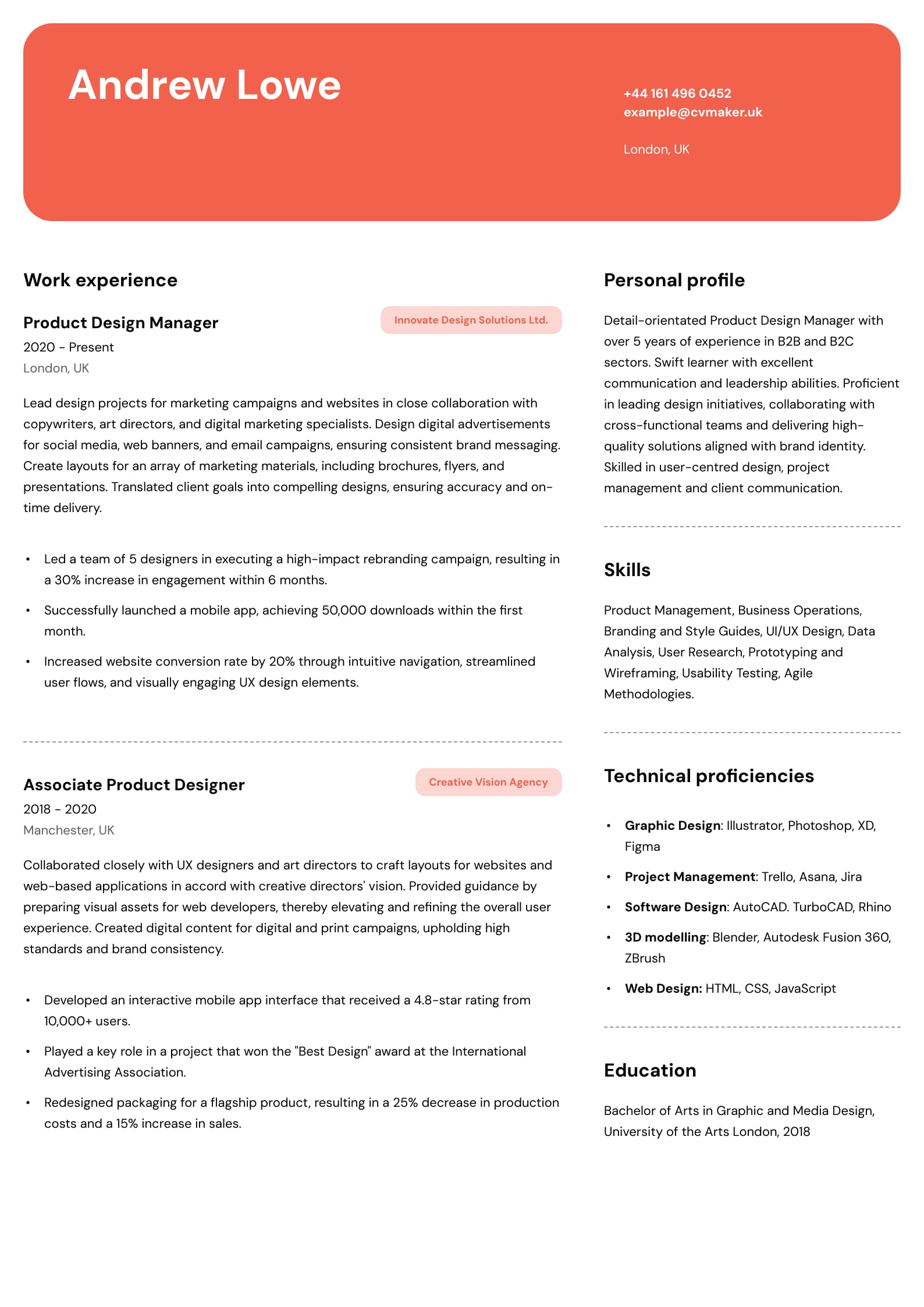
Table of contents
How to Write a Chronological CV in 2024
Creating a structured and targeted CV is essential to leave a positive impression on recruiters or hiring managers, all while guaranteeing its compatibility with applicant tracking systems (ATS) . One popular format that has consistently proven effective is the chronological CV. Whether you're a seasoned professional, a recent graduate, or school leaver , this article is for you.
What are the different CV formats?
In the UK, like in many other countries, there are two primary formats for creating a CV: chronological and skills-based . Each has advantages and is suitable for job seekers in different career situations. Alternatively, consider combining these formats depending on your situation.
Chronological, reverse-chronological, or standard CV format
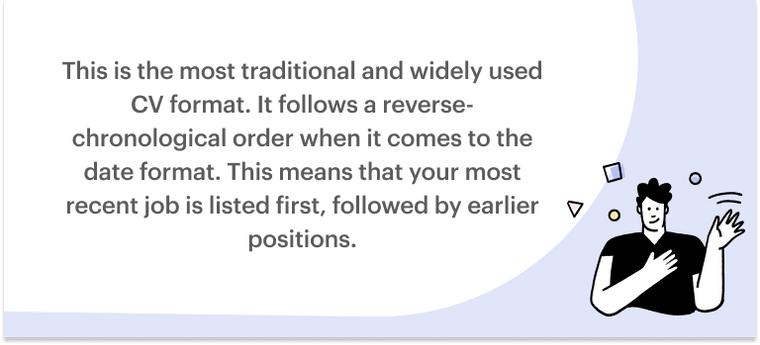
Functional or skills-based CV format
When writing a skills-based CV, make sure to include the following sections while keeping in mind that it can be altered depending on your level of experience or career goals. Refer to our article for more information on how to write a skills-based CV. Alternatively, check out our tips if you are changing careers .
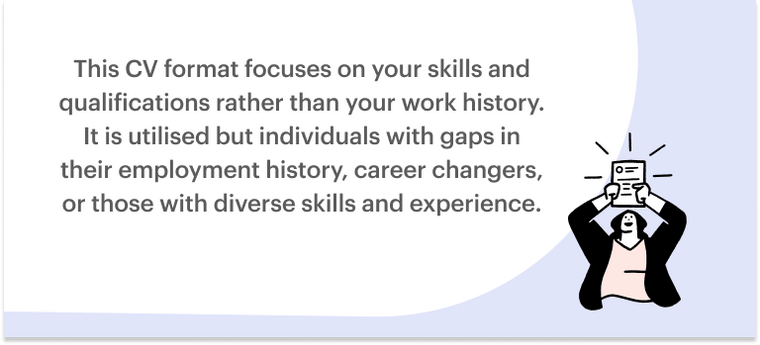
Combination or hybrid CV format
If you're starting your career, transitioning to a new field, or have a gap in employment, consider using this format. It allows you to strike a balance by highlighting your work experience and skills throughout your CV.
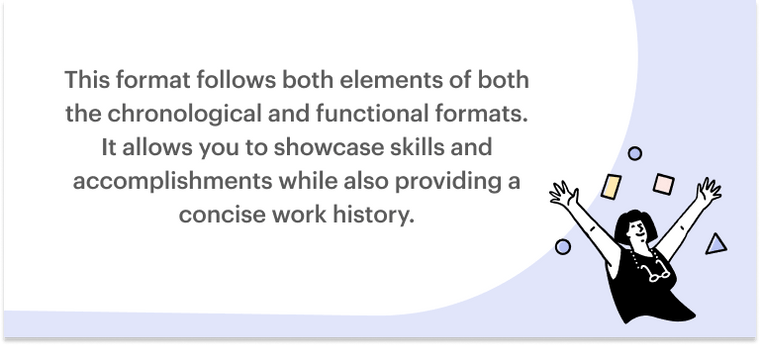
What is the best CV format?
When choosing a CV format, consider your career goals, industry, and the job requirements you're applying for. Tailoring your CV to the position and highlighting the most relevant information is crucial for a successful job application.
A chronological CV is generally preferred when you have a stable work history and want to showcase your career progression. On the other hand, a skills-based CV is suitable when you want to emphasise your qualifications and skills, especially if you have gaps or are changing careers. You can also combine elements of both formats if they best represent your qualifications and career goals.
Chronological CV examples
Support worker chronological cv.
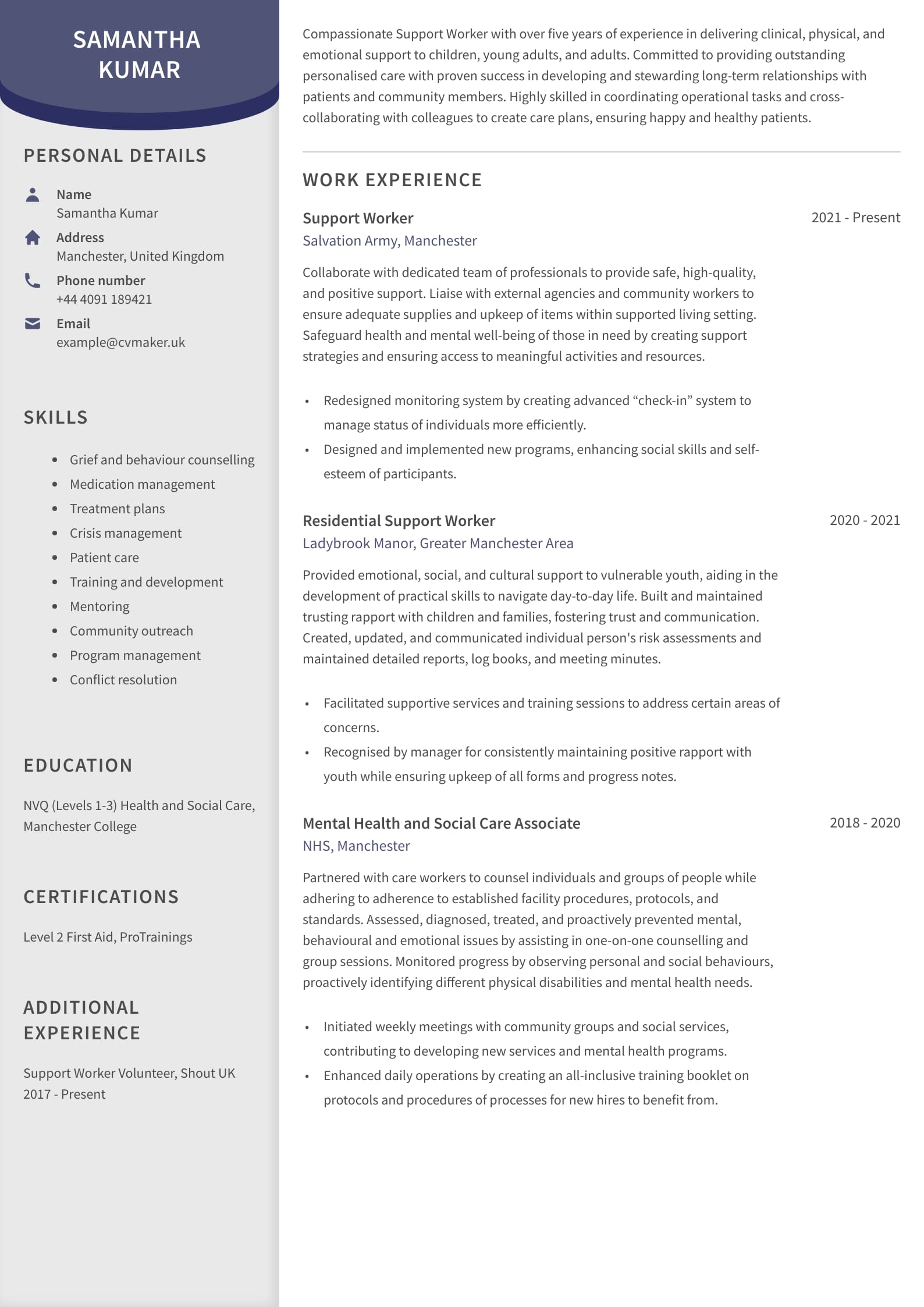
Support Worker CV example
Retail Chronological CV
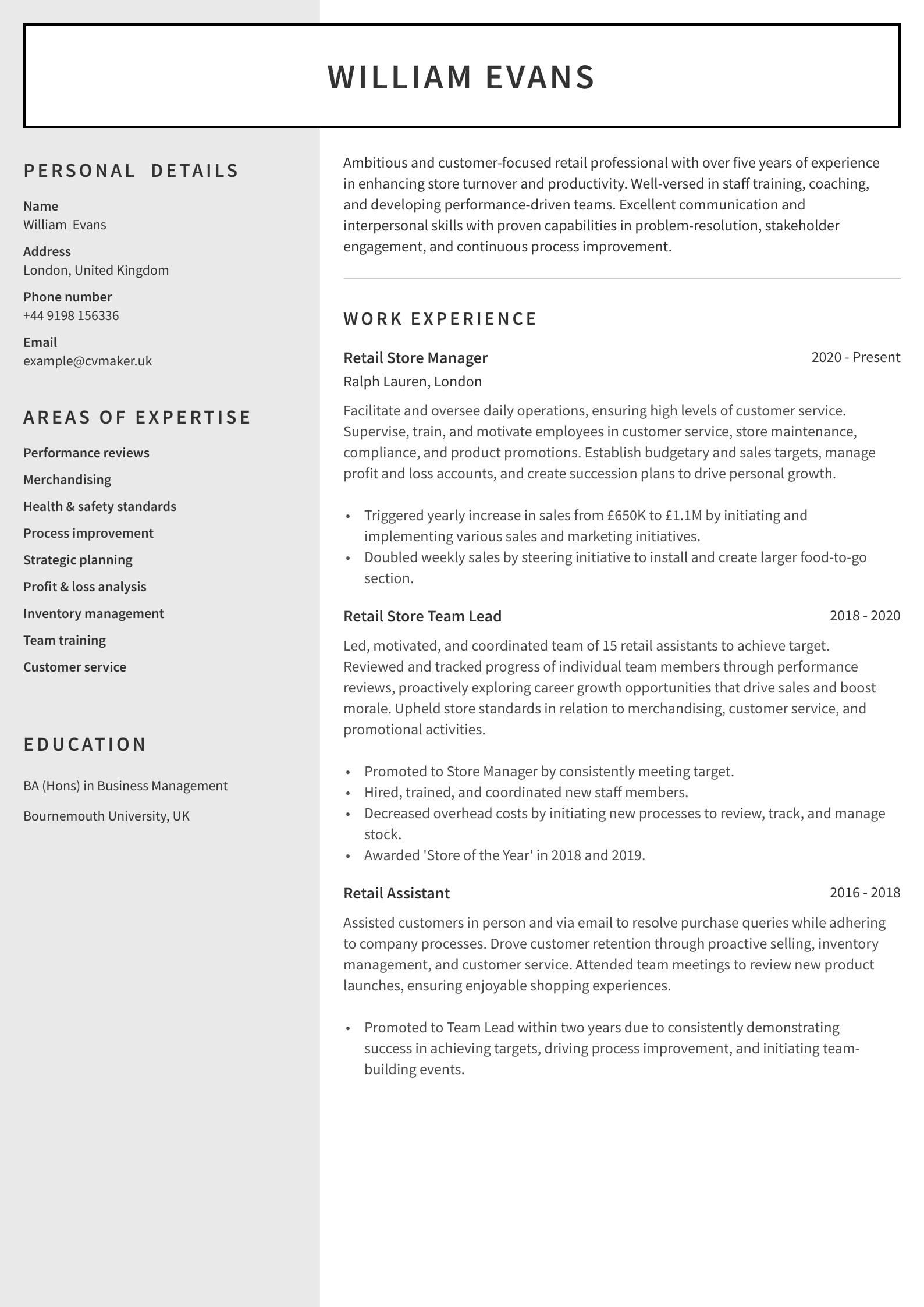
Retail CV example
Marketing Chronological CV
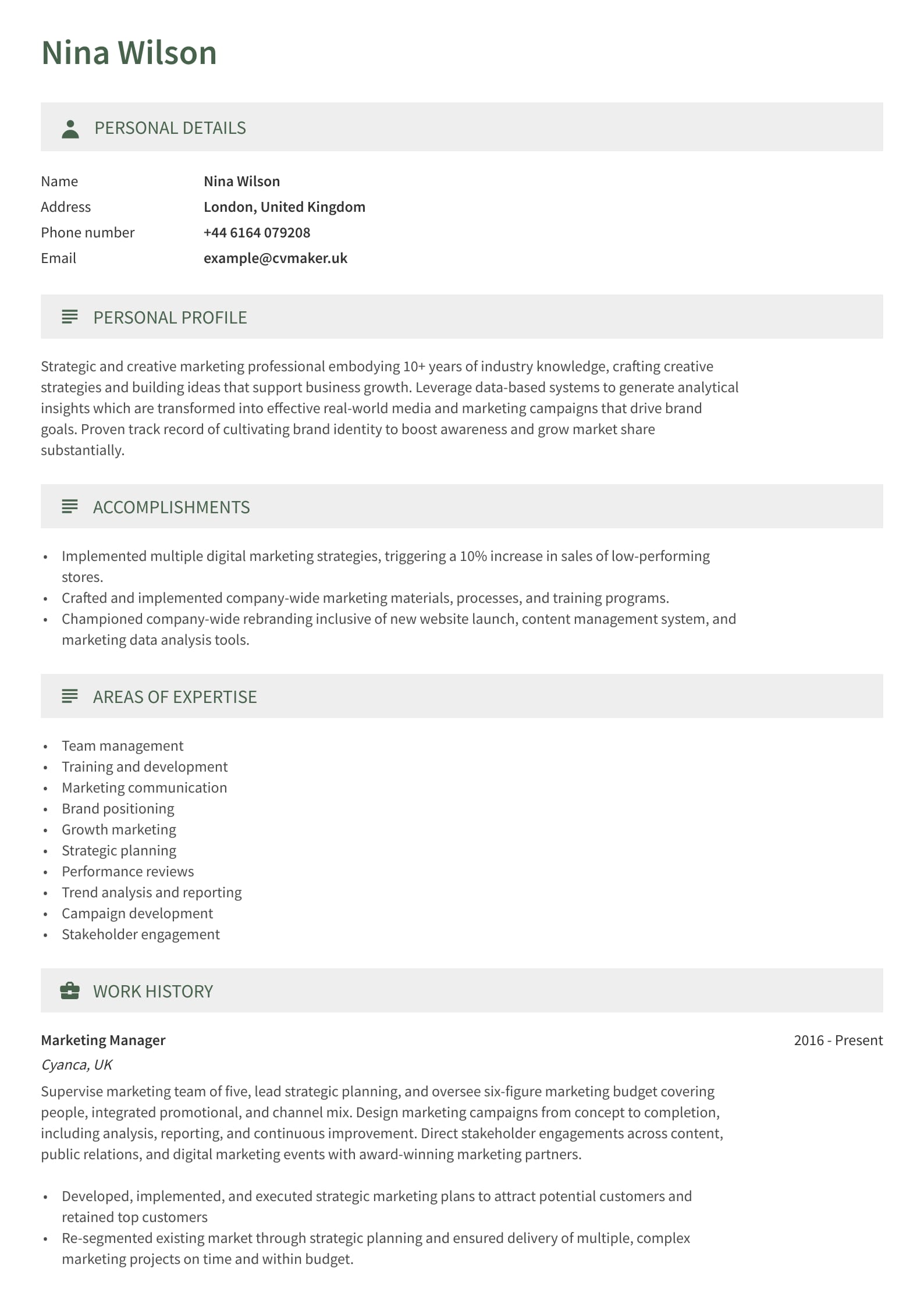
Marketing CV example
French Chronological CV
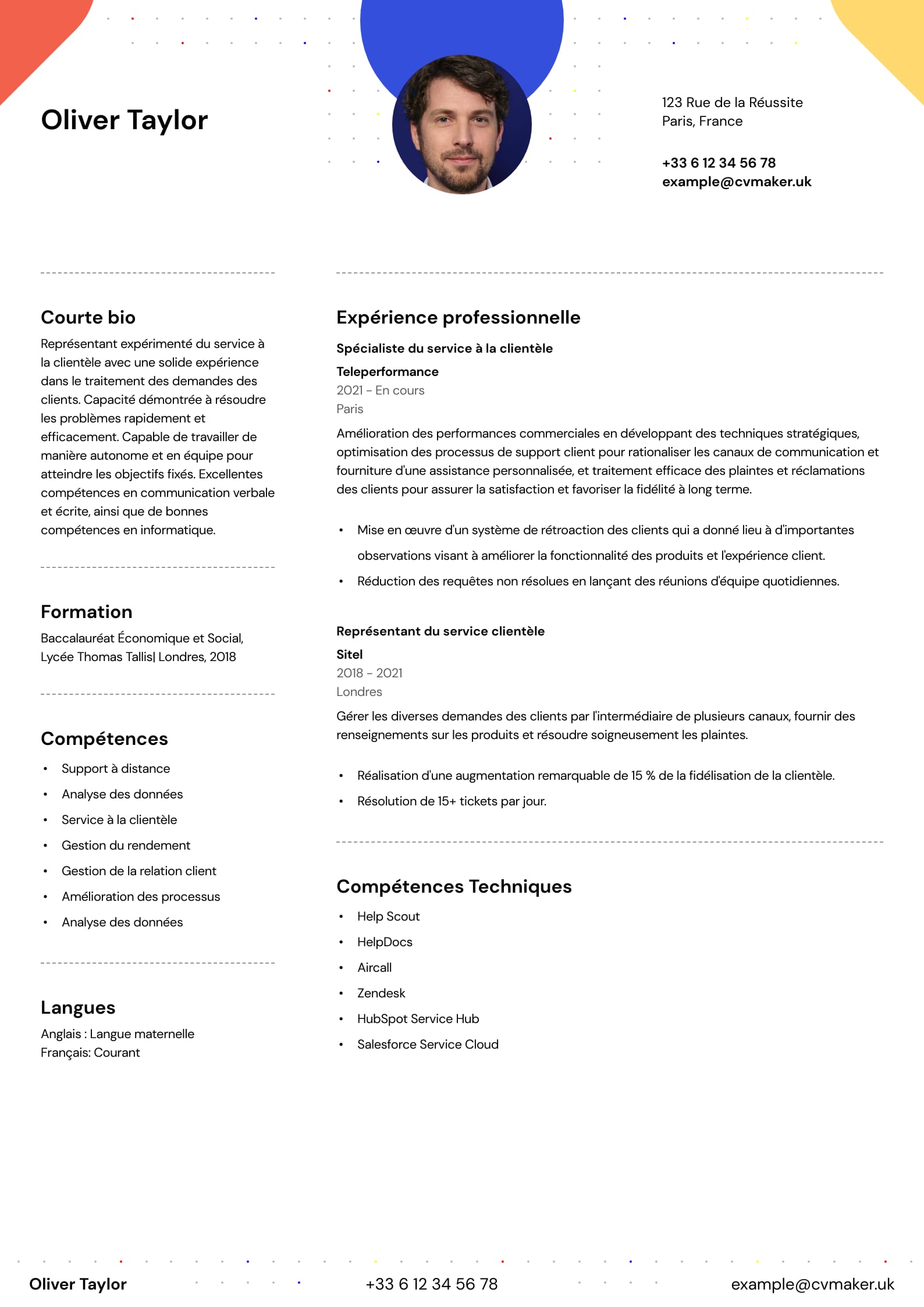
French CV example
Software Developer Chronological CV
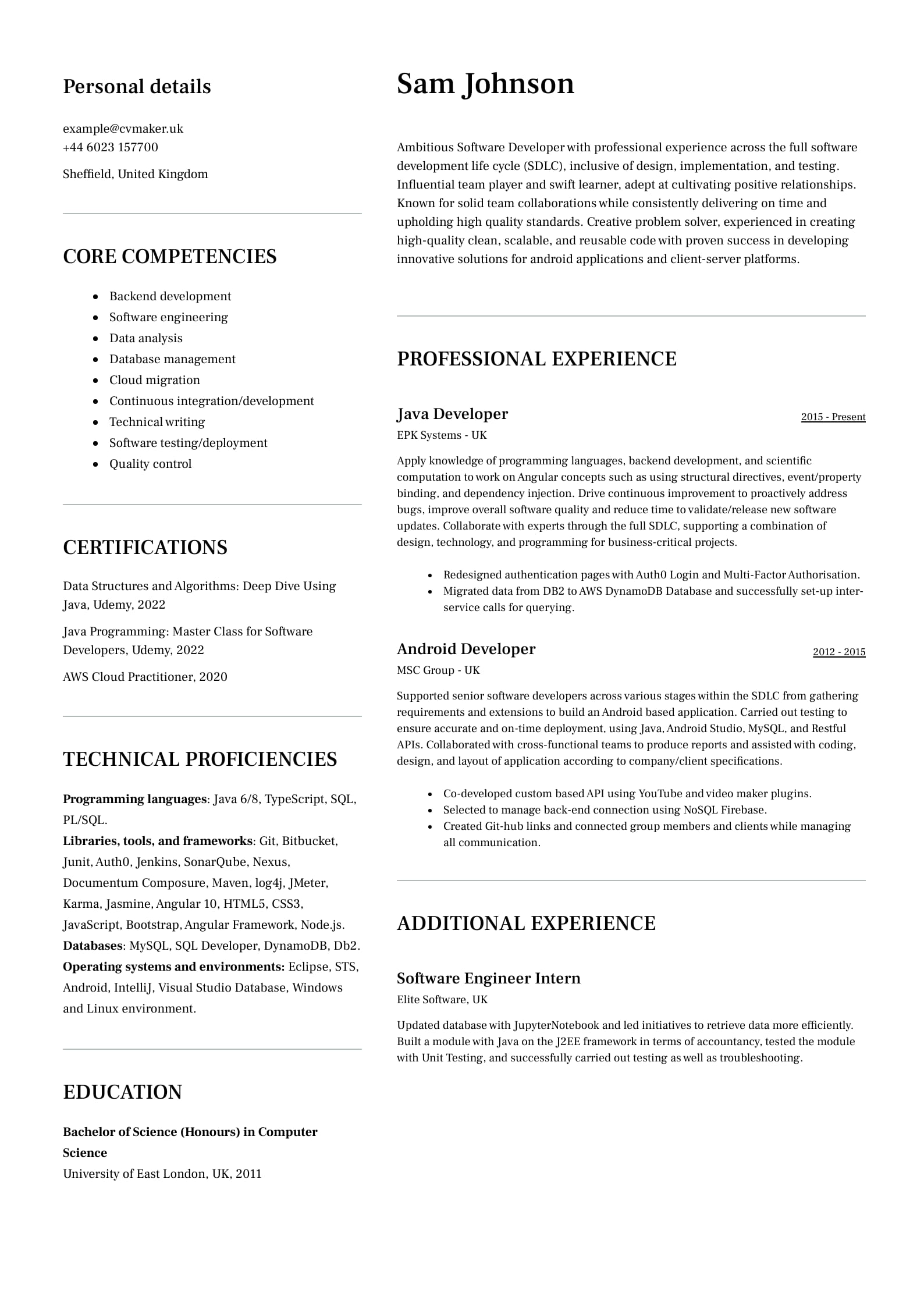
Software Developer CV example
Looking to create a professional CV?
Tips on how to write a chronological cv, 1. create a personal profile.
A personal profile section provides recruiters an insight into who you are and how you can contribute to the company. If you’re a student with little to no experience , then highlight your education, skills, or additional experiences in the personal profile.
2. Describe your experience
The work experience section comes after the personal profile. Research what the role entails so that you can strategically create both duties and achievements . For more information, check out how to write work experience on a CV .
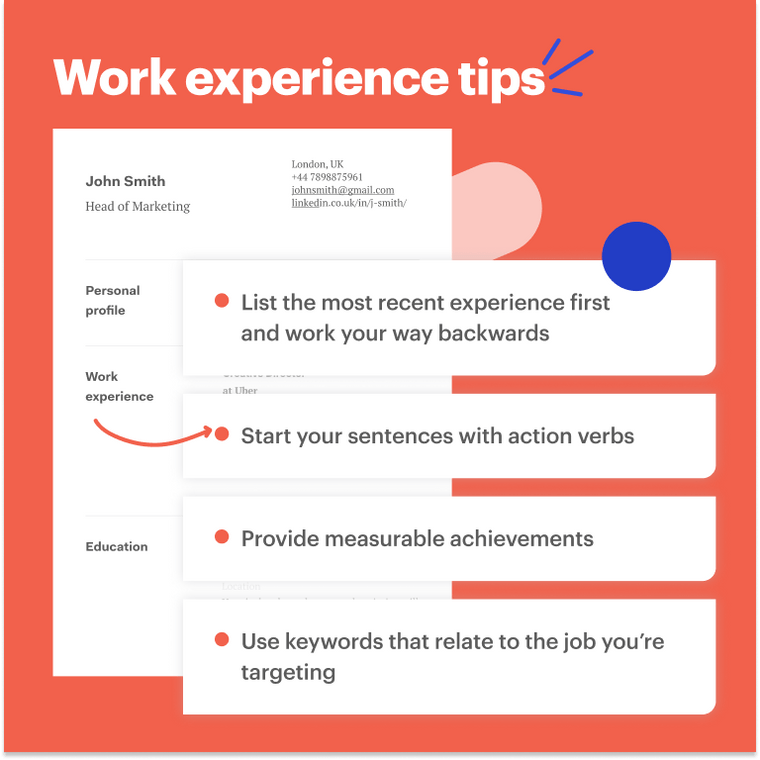
3. List your skills
A chronological CV aims to showcase your hard and soft skills effectively. Rather than having a separate section for skills, integrate them throughout your CV. To learn more, see the article on how to put skills on a CV .
4. Provide your education and qualifications
When listing your education on a CV , there isn't a one-size-fits-all approach. Instead, you can effectively apply various CV strategies to showcase your educational background. As education can be obtained through various means, we recommend emphasising degrees, training programs, or courses and certificates that enhance your CV.
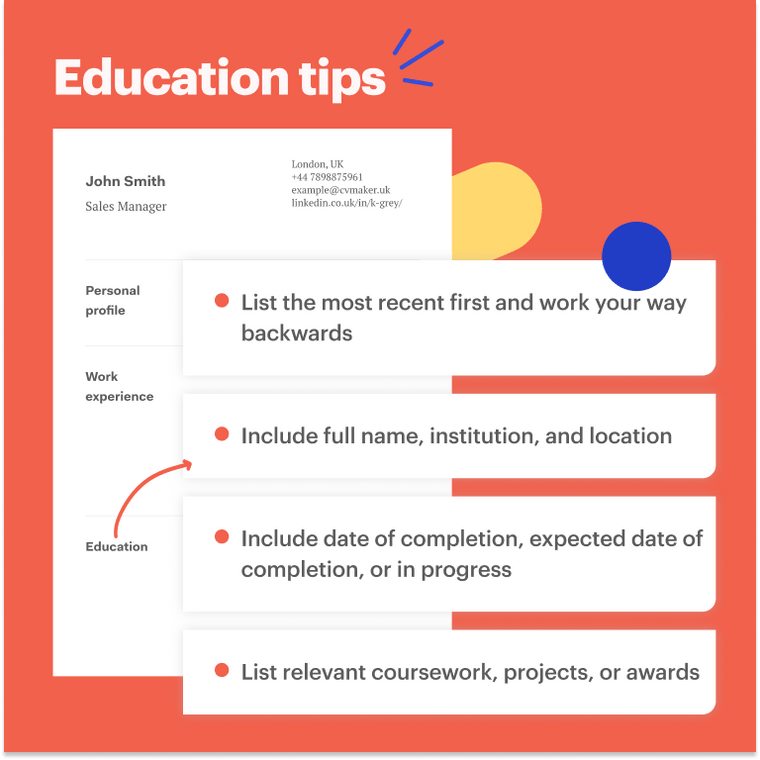
Key takeaways
This article has explored the key components of a chronological CV, providing examples and invaluable tips to assist you in crafting one. With this knowledge, you can create a CV showcasing your unique skills and achievements. Approach your job applications confidently, letting your talents light the way to success in your next role!
Next steps?
Utilise our user-friendly CV Builder to craft a customised CV or cover letter that suits your requirements. Explore our selection of CV examples to assist you in creating a tailored and neatly formatted CV. Take advantage of our CV Writing Service , which provides speedy reviews and comprehensive revisions, guaranteeing your CV incorporates relevant keywords and includes all crucial sections.
What is a chronological CV?
It’s a format that lists your work experience in reverse chronological order, starting with your most recent job and ending with your earliest.
How do you write a chronological CV?
Begin with your contact information, followed by a professional summary, work experience, education, skills, and other relevant sections, such as certifications or awards, in reverse chronological order.
What is the difference between a functional and a chronological CV?
A functional CV focuses on skills and qualifications, while a chronological CV emphasises work history and job progression.
When to use a chronological CV?
Use this format when you have a strong and relevant work history that aligns with the job you're applying for.
When not to use a chronological CV format?
Avoid using this CV format if you have employment gaps or are changing careers, as it may not highlight your qualifications effectively.
Land the interview for your dream job with CVMaker
Effortlessly create your professional CV within 10 minutes and download it whenever and wherever you want!
Increase your chances of landing your dream job with CVMaker.
- Log in
- Site search
Chronological CV example
The most used of all CV types, the chronological CV, sometimes referred to as a traditional CV, displays your most recent experience and achievements first. Take a look at this chronological CV example if you're in need of guidance
Jo Smith 54 Long Street, Anytown, XP9 8JQ [email protected] 07777888999
I am a final-year maths undergraduate with customer service and sales experience in the energy industry. As a tutor and maths club coordinator I can explain maths concepts to all ages and abilities. I am keen to use my maths and commercial skills to train as an energy industry analyst.
University of Birmingham (2020-2023)
BSc (Hons) Mathematics. Predicted 2:1.
Modules included mathematical modelling, mathematics in industry, real and complex analysis and mathematical finance.
Any Town High School (2013-2020)
A-levels: maths, physics, chemistry. AS-level geography.
9 GCSEs including English language and English literature.
Inbound customer service adviser, Energex UK call centre (2020-2022)
- Helping customers assess energy costs and tariffs
- Ensuring quality and compliance standards during the switching process
- Meeting and exceeding sales targets consistently
Maths tutoring for 11+ (2019-2020)
- Assessing pupils level of maths and confidence in their abilities
- Preparing and delivering individual lessons
- 100% pass rate of students
Volunteering
Coordinated Year 7 and 8 lunchtime maths club (2018-2020)
I started Maths Buzz so younger pupils could enjoy and succeed at maths. I had to publicise the group and recruit members. I also had to devise a programme of weekly activities. We had a waiting list at the end of the first term and teachers reported that pupils were achieving more in class as a result of the club.
Activities and achievements
- Anytown High School Heads' Award for School Service for creating and running Maths Buzz
- Duke of Edinburgh Bronze and Silver Awards.
- Member of Birmingham University Cricket 2nd XI
- Captain of Anytown School Cricket 1st XI
- Member of Anytown Rugby Club Under 18's XV
Please be aware that this is an example. Use it as a template to help generate ideas and structure your own CV but avoid copying and pasting. Your own CV needs to be original and tailored to the job you're applying for.
Start your chronological CV with a concise statement demonstrating your motivation for applying for the job. While it's important to list your educational achievements and qualifications, you only need to mention relevant modules.
When it comes to your employment history, recruiters are interested in any relevant experience, no matter the level so don't leave anything out. Alongside your duties, be sure to mention any successes, with a brief description of what you did.
Volunteering is worth adding to your CV, especially if it adds weight to your skills or if it demonstrates skills and experience that you haven't gained elsewhere. The same applies if you play a sport or hold membership to any clubs or societies - activities like this show another side to you.
Find out more
- View all example CVs .
- Discover how to write a CV .
- Learn how to avoid the top 7 CV mistakes .
- Read up on writing a personal statement for your CV .
How would you rate this page?
On a scale where 1 is dislike and 5 is like
- Dislike 1 unhappy-very
- Like 5 happy-very
Thank you for rating the page
CV Examples & Guides for All Jobs [75+ Examples for 2024]

Struggling to create an effective CV?
We don’t blame you!
With the job market being as competitive as ever, you need to make your CV really good if you want to stand out.
To help you out, we compiled a list of 75+ effective CV examples to inspire you!
Let’s dive in!
11+ CV Examples
#1. ai engineering cv example.

Here’s what this AI Engineering CV does right:
- Lists achievements and responsibilities. A good work experience section is a mix between work achievements and responsibilities, and this candidate includes both.
- Separates technical skills. For an AI engineer, technical skills are everything , which is why this CV dedicates them separate space.
- Leverages optional sections. Optional sections like “Certificates” and “Personal Projects” are great for any candidate to show more about their work and who they are.
#2. Administrative Assistant CV Example

Here’s what this administrative assistant CV does right:
- Grabs attention with a resume summary. Done right, a resume summary will hook hiring managers and get them to read the rest of a CV in more detail.
- Keeps the education section brief. For someone with extensive professional experience, the education section shouldn’t take more than a few lines in a CV.
- Uses the reverse-chronological format. This CV example stays relevant by showing the candidate’s most recent work experience and achievements up-top.
#3. Bartender CV Example

Here’s what this bartender CV does right:
- Highlights language skills . Bartenders get to meet all kinds of people, which is why this CV example makes sure to show the candidate is well-versed in three languages.
- Includes all relevant contact information. In addition to the full name and professional email, this CV also includes the candidate's Instagram and LinkedIn accounts.
- Mentions hobbies and interests. Hobbies and interests can help the candidate show a more personal side of themselves, which is why they’re a nice addition to have if there’s enough space on the CV.
#4. Bookkeeper CV Example

Here’s what this bookkeeper CV example does right:
- Details computer skills. About 92% of jobs require digital skills today, which is why the candidate in this example breaks down their computer skills in detail.
- Lists notable achievements . By listing their key achievements separately, the hiring manager won’t have to look too hard to understand why the candidate is the right fit for the job.
- Includes a LinkedIn profile. A LinkedIn profile can be a great way for hiring managers to get to know candidates better, in case they wish to. Just make sure to update yours before you include it on your CV.
#5. Consultant CV Example

Here’s what this consultant CV does right:
- Keeps it under one page. In most cases, a CV shouldn’t go over one page . This CV example uses space effectively and keeps it within the right limits.
- Visualizes language proficiency. Saying you speak a language is good, but showing your proficiency is better. This example even visualizes, making it easier for the hiring manager to skim through the information.
- Leverages a modern template. By taking advantage of a modern and professional template, this candidate doesn’t spend time and effort working on their CV design and layout.
#6. Engineering CV Example

Here’s what this engineering CV does right:
- Separates soft skills from technical skills. Separating soft skills from technical skills makes it easier for the hiring manager to skim through the CV.
- Features a memorable CV summary. This CV summary includes relevant information such as the candidate’s years of experience, their top skills, and their areas of expertise.
- Adds value through a “Certificates” section. By listing their certificates, this candidate shows they’re invested in their field even outside of the workplace.
#7. Graphic Designer CV Example

Here’s what this graphic designer CV does right:
- Elaborates on the work experience. The work experience takes up half the page on this CV, showing the hiring manager they’re looking at the CV of a seasoned professional.
- Lists personal projects. By listing their personal projects, the candidate shows they’re passionate about their job.
- Includes areas of expertise. Being an expert is no easy feat, and this CV example highlights what a hard worker the candidate is by listing them above their technical skills.
#8. Nurse CV Example

Here’s what this nurse CV does right:
- Focuses on professional achievements. Achievements speak louder than responsibilities, which is why this CV example puts them in the spotlight.
- Uses power words and action verbs . Words like “showcased,” “supervised,” and “adhered” are much more impactful than “managed” or “was responsible for.”
- Lists conferences and courses. Medical professionals have always room to grow their careers and, by listing conferences they’ve attended and courses they’ve completed, the candidate shows they’re looking to learn and grow.
#9. Office Manager CV Example

Here’s what this office manager CV does right:
- Lists awards and achievements separately. This CV example dedicates a separate section to the awards and achievements the candidate is proud of and wants the hiring manager to notice first.
- Includes relevant contact information. LinkedIn and Twitter are two of the most “professional” social media profiles that a candidate can include in the contact information section.
- Focuses on work experience over education. With extensive work experience under their belt, this candidate keeps their education section brief.
#10. Sales Associate CV Example

Here’s what this sales associate CV does right:
- Great first impression with a well-organized layout. The layout can make a CV look clean and professional or cluttered and messy. This CV template has a well-organized layout that makes the candidate look professional.
- Provides tangible results to prove achievements. By adding concrete results, the candidate manages to make their achievements more real and impressive to the hiring manager.
- Includes optional sections. “Languages”, “Interests”, and “Conferences and Courses” all add more “meat” to the candidate’s CV.
#11. Server CV Example

Here’s what this server CV does right:
- Uses bullet points to organize information. Bullet points are a great way to organize information so that the document doesn’t look too cluttered with text and too difficult to read.
- Lists all the essential contact information. This CV example focuses on listing only the essential contact information, namely the candidate’s full name, professional email address, phone number, and physical location.
- Includes both hard and soft skills. By separating the candidate’s soft and hard skills and keeping both of these sections relevant to the job application, this candidate guarantees the hiring manager notices they’re the right fit for the job.
#12. Web Developer CV Example

Here’s what this web developer CV does right:
- Focuses on technical skills. For some professions, technical skills are more important than for others. That’s why this web developer CV highlights the candidate’s technical skills by also including their proficiency level for each skill.
- Provides results, timeframes, and actions taken for achievements. This CV example makes the candidate’s achievements super impressive by providing numbers, timeframes, and specific actions taken to prove their results.
- Lists courses and training. By listing their courses and training, this candidate shows that they’re constantly evolving professionally.
65+ More CV Examples and Guides
- Architect CV
- Administrative CV
- AI Engineer CV
- Bank Teller CV
- Bartender CV
- Bookkeeper CV
- Business Analyst CV
- Career Change CV
- College Application CV
- College Freshman CV
- Consultant CV
- Creative CV Examples
- Data Entry Specialist CV
- Data Scientist CV
- DevOps Engineer CV
- Digital Marketing Manager CV
- Electrical Engineer CV
- Elon Musk's One-Page CV
- Engineering CV
- Europass CV
- Event Planner CV
- Executive Assistant CV
- Financial Analyst CV
- Flight Attendant CV
- Graphic Designer CV
- High School CV
- Internship CV
- Java Developer CV
- Military to Civilian CV
- Marketing Executive CV
- Minimalistic CV Examples
- Office Assistant CV
- Office Manager CV
- Operations Manager CV
- Paralegal CV
- Pharmacist CV
- Program Manager CV
- Real Estate Agent CV
- Receptionist CV
- Recruiter CV
- Research Assistant CV
- Restaurant Manager CV
- Retail Manager CV
- Richard Branson's One-Page CV
- Sales Associate CV
- Satya Nadella's One-Page CV
- Social Worker CV
- Software Engineer CV
- Stay-at-home Mom CV
- Volunteer CV
- Waiter/Waitress CV
- Warehouse Worker CV
- Web Developer CV
5+ Examples of CV Templates
The CV template you pick will have an impact on what kind of first impression you make on the hiring manager.
That’s why it’s especially important to pick a template that matches your industry, your career level, and your skills and expertise.
Here are some of our top options to choose from:
#1. Basic CV Template

A basic format with an impactful design that equally highlights all resume sections and allows all your strengths to shine through.
#2. Professional CV Template

Ensure your application looks both modern and professional with this CV template and land the job of your dreams effortlessly.
#3. Creative CV Template

Land the creative role of your dreams with this dynamic CV template made specifically with creative industries in mind.
#4. Minimalist CV Template

A well-organized template that lets your achievements and experience do the talking by keeping a minimalistic approach to design.
#5. Modern CV Template

This CV template lets you show your bold side by using modern design elements such as a yellow color, well-aligned vertical and horizontal lines, and symbols.
#6. Simple CV Template

Simplicity is key, so let this template be the key you need to unlock new job opportunities.
#7. Functional CV Template

Do you have a rich professional background full of achievements and skills? Highlight all your strengths in the functional CV template.
5 CV Examples by Career Level
#1. college freshman cv.

Are you a college freshman looking to score your first gig? Learn how to ace your college freshman CV here.
#2. No Experience CV

Having no experience doesn’t mean you can’t land a job. You can learn how to write an amazing CV with no experience through our guide.
#3. Graduate CV

Finally ready to take on the real world? The first step is to write a stellar graduate CV and land your first “real” gig!
#4. Career Change CV

You don’t have to be afraid of a career change if you have the right tools. A strong career change CV can let your strengths shine through, even if you have zero experience with the new field.
#5. Executive CV

Your professional journey doesn’t end once you become an executive. On the contrary - your executive CV needs to be better than ever before. Our guide can show you just how to do that.
3 Examples of CV Formats
#1. reverse-chronological cv format .

The reverse chronological CV format highlights your most recent work experience and achievements and then goes back in time. This one’s the most popular resume format in 2024.
#2. Functional CV Format

Are you a student with no work experience, a career changer, or someone with a long employment gap on your CV? Then the functional CV format might be the best choice for you. This format highlights your skills over your work experience, making up for the lack of achievements and responsibilities.
#3. Combined CV Format

The combined CV format stays true to its name by combining the reverse chronological and functional formats.
The Perfect CV Structure
Not sure how to start writing your CV ?
No worries.
Whether you’re a seasoned professional whose CV-writing skills got a little rusty through the years or a fresh university graduate, follow our tried-and-tested tips for great results:
- Choose a format or pick a template. In 99.99% of cases, you should go with the reverse-chronological format for your CV and make sure to follow the right layout rules so that your page doesn’t look cluttered and messy. Alternatively, if you don’t want to deal with all the hassle, you can just pick one of the templates listed in this article and have your CV ready in under five minutes.
- Start with the contact information section. Your full name and job title, professional email address, and physical location are must-haves when it comes to contact details. Optionally, you can provide links to your LinkedIn profile , Twitter, or GitHub , if you’re a developer.
- Write an attention-grabbing resume summary. A resume summary aims to grab the hiring manager’s attention from the get-go and have them read the rest of your resume. If you’re an entry-level candidate, we recommend going with a resume objective instead.
- Focus on your work experience. The work experience section is arguably the most important section of every CV. Make your shine by focusing on your achievements rather than on your responsibilities and providing quantifiable results whenever possible!
- List your soft and hard skills. Soft skills are just as important in the workplace as hard skills. Make sure to include all your relevant skills on your CV, but don’t make the mistake of listing skills just for the sake of having them. You want to make sure every skill you list is tailored to the position you’re applying for.
- Keep your education section short and to the point. Unless you have no work experience whatsoever , your education section shouldn’t be too elaborate. Listing the name of your highest degree, institution name, and years attended is more than enough.
- Leverage optional sections. Sections like “Languages,” “Certifications, “Awards,” “Personal Projects,” etc., are not mandatory but can certainly add a lot of value to your CV. If you’re competing against candidates with similar work experience and skills as yours, you can rest assured that the optional sections will make the difference!
FAQs About CV Examples
Are you still looking for more information? Take a look at the answers to the most popular questions about CV examples:
1. How are these CV examples created?
Novorésumé, together with leading HR specialists and recruitment experts, created all the CV examples in this article. We carefully chose the CV design and contents to make sure they meet the standards for their respective industries worldwide.
You can model your own CV after one of the provided examples by using Novorésumé’s CV builder . Start by picking a template and looking at examples of CVs for your industry, and then use the CV examples for inspiration when writing your own.
2. Can a CV be two pages?
Unless you have over 5+ years of extremely relevant work experience or you’re applying for a management position, your CV shouldn’t extend past one page.
Add only your most recent experience and achievements, and make sure to focus on the most relevant information for the job you’re applying to.
Nearly 50% of hiring managers say that overly long CVs get candidates rejected, while 17% think two pages are a deal breaker.
3. How do I write an attractive CV?
There are several things you can do to create an attractive CV.
For starters, you should make sure you follow the right layout rules in terms of margins, font size, and style, line spacing, etc. Alternatively, you can opt for a CV template and skip all the design hassle. A professional CV template offers you the chance to get an attractive CV, in less than five minutes.
That said, you should also make sure that your CV sections are well-aligned and relevant to the position you’re applying for.
If a hiring manager looks at your CV and thinks it looks good but then starts reading it and sees its contents are of-point, they will not find your CV attractive.
4. What is the CV structure for 2024?
The ideal CV structure for 2024 is:
- Contact information
- CV summary/objective
- Work experience
- Optional sections (languages, certificates, awards, etc.)
Create your Europass CV
The Europass CV builder makes it easy to create your CV online. You can use it to apply for a job, education or training opportunities as well as volunteering.
The best-known CV format in Europe
The Europass CV is one of the best-known CV formats in Europe. It is easy-to-use and familiar to employers and education institutions.
You will first have to create your Europass profile with information on your education, training, work experience and skills. After you complete your Europass profile, you can create as many CVs as you want with just a few clicks. Just select which information you want to include, pick your favourite design and Europass will do the rest.
You can create, store and share CVs in 31 languages . You can download your Europass CV, store it in your Europass Library share it with employers, with EURES or other job boards.
How to create a good CV
Remember that your CV is your first opportunity to communicate your skills and experiences to a future employer. It is a snapshot of who you are, your skills, your educational background, work experiences and other achievements.
Present your experience clearly
Highlight examples of your skills and experiences matching the job you are applying for. Pay close attention to the details published in the vacancy notice.
Tailor your CV
Make sure you update the ‘About Me’ section to highlight why you are the best person for the job. Do not include a full detailed history. Focus on facts and main points that match the job you have in mind.
Make it readable
Make sure your CV is easy to read. Use clear and simple language. Use strong verbs (e.g. ‘managed’, ‘developed’, ‘increased’).
Use reverse chronological order
Always list the most recent experience on the top followed by previous ones. In case of long gaps in working or learning, include an explanation.
Polish and fine-tune
Check for spelling and grammar mistakes, provide a professional e-mail address, and add a professional photograph of yourself.
Your Europass profile
Your Europass profile is the place to keep a record of all your skills, qualifications and experiences. If you keep your Europass profile up-to-date then you will always have all the information you need to create tailored CVs and job applications quickly.
Good luck with your applications!
Find support through EU services
Eures the european job mobility portal, working abroad in other eu countries, education and training in other eu countries, you may be interested to read.

Create your Europass Cover Letter

Develop your skills through volunteering

Managing your personal information in Europass
Share this page.


IMAGES
VIDEO
COMMENTS
CV templates This CV example demonstrates the type of info you should be including within your Chronological CV, as well as how to format and structure the information in a way which looks professional and is easy for time-strapped recruiters to read.. This is the look and feel you should be aiming for, so remember to refer back to it throughout your CV writing process.
Here are three examples of chronological resumes you can download and use for reference: 1. Chronological resume example for a financial advisor ... LinkedIn profile; Note that while adding a mailing address to your resume used to be standard practice, it's no longer necessary because most employers will contact you via email. 2. Open with a ...
Here are the steps you can take to write a chronological resume: 1. List your contact information. Begin with your name and contact information. Provide your phone number, email address and location, including your city and state.
So when you list your achievements under your experience, use strong verbs that can paint a picture of who you are and what you can do. #5. Pharmacist Chronological Resume. With plenty of attributes up their sleeve, the chronological format is the perfect choice for a pharmacist's resume . #6.
The best course of action for writing a chronological resume is to start off with a rough outline (or use a template ). In your head or on paper, list out every work-related experience you've had. Based on that information, decide how you want to sort that information and how many "sections" of your resume you want to create.
Chronological resume format for a warehouse manager. Like this reverse-chronological resume example, use your work history to show how you've improved operations and profits as a manager, using specific numbers that demonstrate your effectiveness (e.g., improving inventory accuracy by 25%). Use this template.
The chronological resume format is the most popular resume format worldwide. Learn how to write it with our comprehensive guide! ... Chronological Resume Example & Writing Guide. ... Administered the agency's social media profiles, including Facebook, Twitter, and Instagram, created weekly posts, organized contests, and replied to messages. ...
2. Write Your Career Statement. The next thing to add to your chronological resume is your career statement or candidate profile. This is done in the form of either a resume summary or a resume objective. A resume summary is a brief overview of your professional experiences.
Get fill-in-the-blanks chronological resume templates and follow our pro tips to create your job-winning chronological resume for any job. ... Chronological Resume: Format, Templates & Examples. 02/19/2024 Chronological Resume: Format, Templates & Examples. ... Resume profile; Work experience (going up to 10-15 years back from the latest job)
With a chronological résumé, it is crucial to start with a compelling profile that can grab recruiters' attention. Your personal profile should summarise your objective across three to six lines, and include things like experience, qualifications, skills, industry knowledge, and familiarity with relevant tools and software. 3. Skills section
5 additional writing tips. 1. Prepare. Before you start writing your resume, list your job history in reverse-chronological order. You should also create a list of career accomplishments and the skills you used to achieve them. Considering what you want to feature will make it easier for you to put it all together!
A chronological resume is a format that lists all of your work experiences, education, training, and anything else you include sorted by dates. You'll also hear it called a reverse-chronological resume because the best practice is to start with your most recent experience first and work backward.
Here's a quick chronological resume example for an elementary teacher: Elementary School Teacher. Reed Valley Elementary, Knoxville, TN. October 2020 - Present. Improved student test scores by 20% and pass rate by 25% from 2020-2021 school year to 2021-2022.
A chronological resume, also known as "reverse chronological resume" is the most commonly used resume format. Recruiters all over the world prefer it because of its straightforward and easy-to-read style. If you have a rich work history, a chronological resume format is an ideal choice for you.
Well, this guide is going to answer all these questions and more about the famed reverse chronological resume format. List the most recent job frist and then date back to the previous ones. Write dates (in mm/yy - mm/yy) format thoughout your resume. Helps in highlighting the professional experience section.
A chronological resume, also known as a reverse-chronological resume, is one of the most commonly used formats in the job market. In this format, your work experiences are listed in a chronological order, starting from the most recent job to the oldest. It highlights the progression of your career and accomplishments over time. Benefits of using a chronological resume The chronological resume ...
Chronological CV Template: (Text Version) [Write your personal profile. Craft a paragraph of 100-400 words highlighting your skills and work experience most relevant to the position you're applying for. Describe who you are as a professional, what you can offer the company, and what your overall career objectives are.
Tips on how to write a chronological CV. 1. Create a personal profile. A personal profile section provides recruiters an insight into who you are and how you can contribute to the company. If you're a student with little to no experience, then highlight your education, skills, or additional experiences in the personal profile. 2.
How to write a CV using a chronological format. Below are some steps you can follow to create a CV with a chronological style: 1. Create a header. Your document's header contains your personal details and contact information, including your first and last name, phone number, email address and location.
May, 2023. The most used of all CV types, the chronological CV, sometimes referred to as a traditional CV, displays your most recent experience and achievements first. Take a look at this chronological CV example if you're in need of guidance. Jo Smith 54 Long Street, Anytown, XP9 8JQ [email protected] 07777888999.
Uses the reverse-chronological format. This CV example stays relevant by showing the candidate's most recent work experience and achievements up-top. #3. Bartender CV Example ... A LinkedIn profile can be a great way for hiring managers to get to know candidates better, in case they wish to. Just make sure to update yours before you include ...
These examples show you how a CV profile works in practise. Professional profile on a chronological CV: examples. The first one comes from a senior marketing specialist CV. GOOD EXAMPLE Self-motivated and analytically-minded senior marketing manager with 6+ years of experience. Eager to join Minas Morgul Inc. to help manage the strategy ...
Academic CV. An Academic CV is slightly different to a CV for a non-academic job seeker. For a start, it is acceptable for it to be longer as there are often publications, grants and research interests to include. A standard UK CV is 2 pages, but often an academic CV will be longer. This type of CV is really a chronological CV, except it has ...
3 main types of resume formats. Luckily when it comes to choosing a resume format, your choices are already narrowed down to three main types: Reverse chronological. Functional. Combination. Each one offers unique advantages and there are no best resume templates.
The best-known CV format in Europe. The Europass CV is one of the best-known CV formats in Europe. It is easy-to-use and familiar to employers and education institutions. You will first have to create your Europass profile with information on your education, training, work experience and skills. After you complete your Europass profile, you can create as many CVs as you want with just a few ...
Resume Builder offers free, HR-approved resume templates to help you create a professional resume in minutes. 1. Craft an outstanding profile with a summary of your health care qualifications. A strong profile lets you impress hiring managers from the moment they start reading your resume.
1. In a 'certifications and licences' section. You can start by highlighting your credentials in a dedicated certification section on your CV. Depending on how it is formatted, you can add this section under the 'education' section or the 'skills' section of your CV. A common name for this section is 'certifications and licences ...
Build Your Resume. Resume Builder offers free, HR-approved resume templates to help you create a professional resume in minutes. Start Building. 1. Write a brief summary of your nurse qualifications. Your profile, also known as the summary of qualifications, is one of the most important aspects of a resume.